

The story so far:
Knight of the Fox
Son of the Knight of the Fox
Son of the Knight of the Fox - Part 2
I'd already planned to keep reading through Grant Morrison's bibliography, but wasn't planning on talking about any new books until Deltarune Chapters 3 and 4 drop. Then I realized if I did that, I'd be in for a shitload of work. I'd have to talk about a bunch of new books alongside four chapters of Deltarune AND how all the previously read books parallel Deltarune Chapters 3 and 4 AND how the new information gleaned from Chapters 3 and 4 changes previous speculations, all while nursing the splitting headache I'm going to have if Chapter 3's secret boss really does turn out to be Christopher Reeve with a big bomb.
While the last two pages were posted as a whole, this one was updated as I read Morrison's books and to be honest, while I did find some good stuff like Batman: The Return of Bruce Wayne through most of it I felt like I was picking over the bones of a roasted chicken that'd already had most of the meat stripped off. There's not a lot to say about Klaus besides Klaus being a Santa Claus origin story and another name for Santa Claus being Kris Kringle. I'd like to see if future chapters of Deltarune have any similarities to New X-Men beyond Professor X questioning the existence of free will before dedicating a section to that. I relegated 52 to the same "I'll reference it where it's relevant" category as Crisis on Infinite Earths because Morrison only collaborated on it. And Sebastian O, The Mystery Play, and Kid Eternity are some of Morrison's most obscure and niche books so until Deltarune has the Fun Gang attend a religious play that gets interrupted but the murder of the actor who plays God, I'm going to assume any similarities they have to Deltarune are overlaps in Morrison's philosophy rather than Fox pulling from the books themselves.
And since you might be wondering, no, I don't believe Morrison's Klaus has anything to do with the Netflix movie about the postman who's basically Emperor Kuzco.
The biggest problem I'm having with The Invisibles is, well, in my mind philosophy and themes should enhance a strong story, like a dash of A1 sauce on a steak. The Invisibles is so heavy on Morrison's philosophy that reading it is like drinking A1 straight from the bottle. So I need a break from the madhouse that is Morrison's psyche before I even try to piece together what the hell is going on in it or The Filth, and I'm not that interested in reading Morrison's 2022 novel, Luda, unless a future chapter of Deltarune features magic drag queens.
And honestly, my coverage of Zenith feels a little dry, which to my mind is a sign I'm getting burned out and need to take a break from this. If a Deltarune newsletter contains anything juicy I'll go ahead and add it, but whether or not this page sees another major update depends on if I recoup enough brain cells to tackle The Invisibles before Deltarune Chapters 3 and 4 release.
Latest Update 8/30: Zenith, More on Tarot Cards, Additional entries to More Odds and Ends, Closing Thoughts
But first, a discussion I've been wanting to have for a while.
In the last two parts, I've occasionally brought up the term "apophenia." Appropriately enough, there's a meme of the Question explaining it.

In other words, it's when people form meaning in random nonsense. It's the thing that causes people to see Jesus in a grilled cheese sandwich, sync Pink Floyd's The Dark Side of the Moon with The Wizard of Oz, or in the case of the Kimba/Lion King controversy claim The Lion King clearly ripped off Kimba the White Lion because of straw-grabbing bullshit like Kimba and Simba both having a love interest, or both frequently showing characters standing on cliffs. Because Kimba the White Lion is the only story to ever have a love interest and characters standing on cliffs prior to The Lion King.
By the way, that is not an animation error, the Question doesn't have a face.
As I analyze Grant Morrison and Toby Fox's works, I'm trying my best to focus on major themes and key story moments and not bog these articles down with inconsequential garbage and things that are clearly Morrison and Fox both pulling from common tropes. For example, in Joe the Barbarian the statue of the Iron Knight is holding a chain.
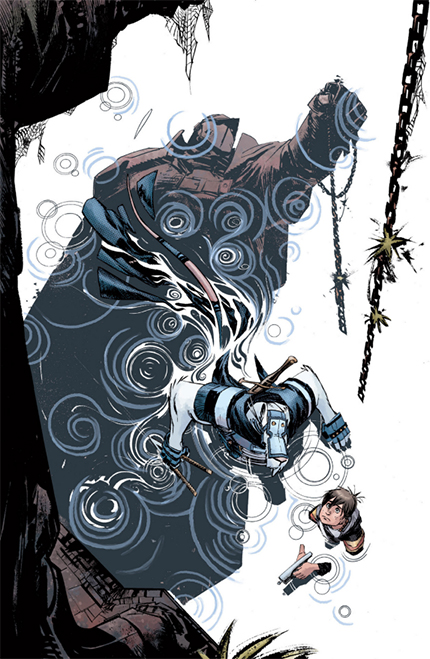
Yes, there is a minor mistake in that he's holding the chain in his right hand on the cover there, but in his left hand within the book. I'm not going to beat Sean Murphy over the head with it because he probably just had a brain fart over the cover focusing on the statue's reflection rather than the statue itself, and I can't even put penguins on blankets correctly.
And during the neutral Spamton NEO fight, he refers to Kris being a "heart on a chain."

But chains are a common symbol of imprisonment and control. The Iron Knight imprisoned King Death within the Hypogean Labyrinth years ago, and Kris is under the control of both the player and whatever entity makes them slash Toriel's tires in the ending of Chapter 2 (*cough*Toby Fox*cough*). And chains parallel the strings of a puppet, both being long, flexible, relatively thin items used to control the movements of something else. At most you could argue the chain of the Iron Knight parallels Kris being bound by the chain of the Roaring Knight, and Joe is standing directly under the chain on the cover art, but even that's a huge stretch. So unless a future chapter is going to have Spamton giving the kids a history lesson under a bigass statue of the Roaring Knight holding a chain, there's no reason to even suggest Fox got the idea for the "heart on a chain" comment specifically from the statue of the Iron Knight.
A wire-covered telephone god that randomly talks in snippets from other conversations is a lot more specific.
I didn't even mention how the Telephone Avatar is kept in the depths of the Pentagon while the NEO Machine is kept in the depths of Pandora Palace, or how the first thing the Avatar says when it emerges is "It's for you." And yes, the Avatar is charging up a BIG SHOT there.
For another example, in We3 the armors of the three pets are colored blue, pink, and green, the same colors Deltarune uses to represent Kris, Susie, and Ralsei.
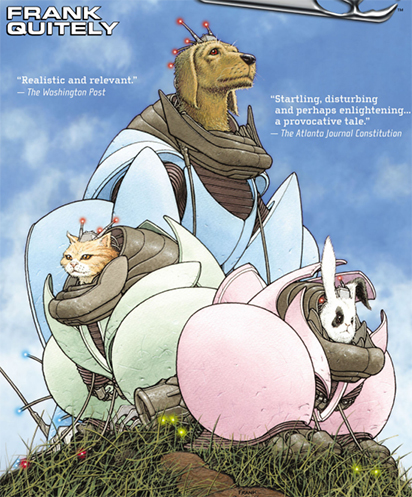
But red, blue, and green are the primary colors of light-based or additive colors (compared to red, blue, and yellow, which are the primary colors of pigment-based or subtractive colors). And because the colors of the armor sets are pastel, red becomes pink.
Some things are muddier, like how in the climax of Akrham Asylum Batman starts attacking the place with an axe which he then sets at the feet of the Joker, a clown based on the Joker card.

Susie uses axes for weapons and Jevil, a clown based on the Joker card, turns into a weapon for Susie - albeit a scythe - if you beat him violently. I can see how Fox could have pulled inspiration for Jevil from this moment, but I can also see how it's just me making connections where there are none. When I make observations like this, I put it into the "strange" category as opposed to "creepy."
A cartoonishly-dressed hypnotist named Jervis rambling about how everything is "just words on a page" is very much in the "creepy" category.
Likewise... okay, for people who aren't familiar with Doom Patrol, Cliff was a NASCAR driver who was involved in a hideous accident during one of his races, destroying his entire body except for his brain (again, in the comic. In the show he evaded the NASCAR accident only to be decapitated in another car accident). Caulder acquired the brain and put it into a robot body, so Cliff is a human brain in a robot body. But when Dorothy releases the Candlemaker it tears his brain out of his body and smashes it, causing his consciousness to be downloaded to a backup disc within his robot body. To override Caulder's catastrophe program, Magnus pulls the disc and pops it into the Think Tank.

You've already figured out where I'm going with "somebody being transferred to a removable disc in a robot body"

Though, yeah, Cliff's disc is in his chest while the NEO Machine's disc is in the head, but Cliff's head used to contain his brain.
Then there's the things I fully admit are amusing coincidences. I'd be very surprised if Fox got his old Internet handle from that one page of Animal Man, it's far more likely Mike was named after Mike Teavee from Willy Wonka and the Chocolate Factory than the guy Peter Milligan made Buddy's wife have an affair with, and as bizarre as the whole Ruby Fox thing is, "ruby" just means "red" and red is the color most commonly associated with foxes (unless Toby Fox read Zenith and took Ruby Fox as another sign he was destined to become the Grant Morrison of video games, despite Ruby Fox being a woman).
When you cross-examine the parrot in the first Phoenix Wright game, there's a point where the Judge says "Once is a coincidence, twice is a pattern." That's the rule I'm trying to go by here; the more similarities something has and the more specific they are, the more attention I'm going to give it. Lennox getting into a robot to fight Buddy isn't anything noteworthy, happens all the time. Not even the fact Bugman is blue, they probably chose that color because blue is the closest color to steel out of the six primary and secondary colors, and to contrast his big red eyes. It's the fact Bugman is a big blue robot that shoots battery acid that makes him uncomfortably close to Giga Queen.
Once you set a foothold in the big things, like characters referring to the higher reality as "Heaven" and alluding to "Heaven" watching them, people "shambling aimlessly towards oblivion" and "lost eternally in an endless night" following the death of their dreams, the insane members of a facility with an alliterative name being the ones who are truly free, and, well, the entire plot synopsis of Joe the Barbarian, it becomes easy to wander off into the weeds of irrelevant, conspiracy theory bullshit that doesn't mean anything, like Agent "!" having a bird cage for a torso, which is where his heart would be if he had one instead of an airplane with legs, and Kris tearing the heart-shaped SOUL out of their torso and throwing it into a bird cage at the end of Chapter 1, or how you can rearrange "Lennox" into "Elnxno," and X is a wild-card letter, and Lanino - who looks a hell of a lot like Lennox - is named after the "Elnino" weather effect. Just... I'm trying to stay on the path here. I'll let you judge how successful I am.
And with our discussion of apophenia fresh in your mind, yes, "Final Crisis" does sound a little like "Final Chaos."
Final Crisis has got to be the most batshit of Morrison's books I've read so far, and when that includes Doom "One of The Main Characters is a Sentient Crossdressing Street" Patrol, that is saying something. In Supergods, Morrison talks about their thought process behind Final Crisis: comics are stories, and what better way is there for a story's reality to unravel than for the story itself to turn to complete nonsense?
And if it wasn't for that little nugget of information from another book, I'd have no fucking idea what was supposed to be going on at all.
My discussion of Final Crisis is going to differ from previous books because the story itself only had a single direct parallel to Deltarune that I caught. So far, anyway. Maybe more will pop up when we get to the Roaring, Final Crisis being about averting a world-ending catastrophe and all. But I don't have a crystal ball nor the means to drag Fox out into the street and demand answers at gunpoint, so I can't tell you if the Roaring is undone by Ralsei singing into a literal Deus Ex Machina.

It does, however, feed into Deltarune being a collection of infinite possibilities that exist together and what I said at the end of the original Animal Men/Deltarune essay, that a fanfic where baby Spamton buddies up with the kids after the NEO fight is no less real than Fox's official telling of the events.
So, what is Final Crisis about, anyway? There's this big baddy in the DC Universe, Darkseid (pronounced just like "dark side"), who rules over a planet of dark gods called Apokolips. Since I'm sure more people are familiar with Marvel lore than DC lore through the MCU, Darkseid is the Thanos of the DC universe although it's more accurate to call Thanos the Darkseid of the Marvel universe but let's not get bogged down with semantics here. If you recall those Animal Man cartoons I linked to where he's voiced by Weird Al Yankovic, the second one ends with Buddy flying by this big purple guy and muttering "Can you believe that guy?" That's Darkseid.
He's just won a war over the good gods of New Genesis and has his sights set on universal domination, but in the process is tearing reality itself apart. One of his tools is the "Anti-Life Equation" which is described as a mathematical proof that Darkseid is the true master of the universe, but let's just say it's a signal that brainwashes anyone who hears it.

And there's your sole direct link to Deltarune.

Final Crisis has two big big "what the fuck am I reading?" tie-in metastories, one for Superman and one for Batman. Morrison was able to explore metafiction with Animal Man because, to put it bluntly, nobody gave a shit about Animal Man. Superman and Batman have more lore, alternate continuities, and reboots to play with, but people tend to be a lot more, let's say, protective of them.
In an attempt to impress Lex Luthor and get him to pledge himself to Darkseid, Darkseid's prophet, Libra, organizes an attack on the Daily Planet that leaves Lois Lane fatally injured. A mysterious woman promises Superman an elixir that can grant any wish if he aids her, and intending to use it to save Lois' life, Superman agrees.
This elixir is called "Bleed" and the worlds of the Multiverse are said to form within it. The Multiversity calls the space between universes the Bleedspace, and because Bleed can alter reality and grant any wish, Bleed is blatantly the water of the Dreamtime.
While recruiting Supermen from across the 52 universes, he ends up leaving the Multiverse entirely and crashing into Comic Book Limbo from alllll the way back in Animal Man.

Okay, stupid irrelevant question time: doesn't writing Limbo into a story remind everyone of these characters and bring them out of Limbo? Also, is fanfic enough to get somebody out of Limbo or do they only get out when an officially sanctioned monkey writes them out? Like if you wrote crossover fanfic of the Green Team and Scrooge McDuck teaming up against Montana Max and Rupert Murdoch - I dunno, maybe you lost a bet and have to, or you're completely smashed on cheap vodka and in your stupor decide that's something that needs to exist - does that get the Green Team out of Limbo?
Alright, back on track. Hoping to find the information they need to get out of Limbo, they get Merryman to lead them to Limbo's library, which only contains a single book. Except that book contains every other book in existence. Even Deltarune's design documents, I guess. So there you have it, folks, Deltarune is part of DC canon.
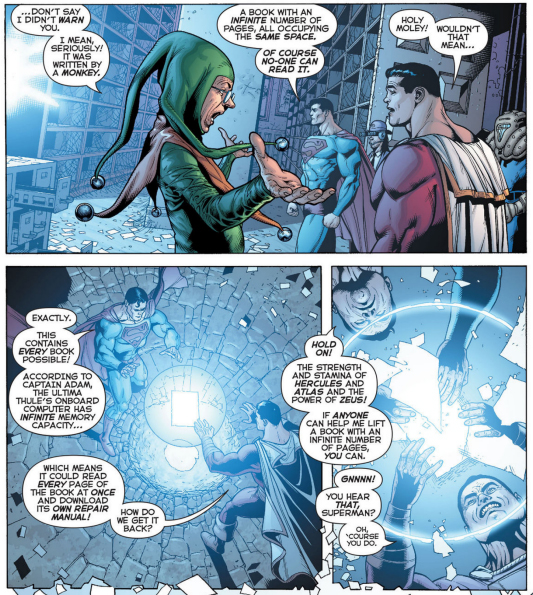
This side story ends with Superman being being combined with Ultraman into a giant, living story and having a kaiju battle with a giant vampire or something, seriously, Morrison gets so fixated on using Final Crisis to explore metanarrative and fiction as alternate realities that it gets in the way of the actual story.
By the way, one of those alternate universe Supermen Supes recruits? Nazi Overman. So, uh, Morrison brought him back prior to The Multiversity.
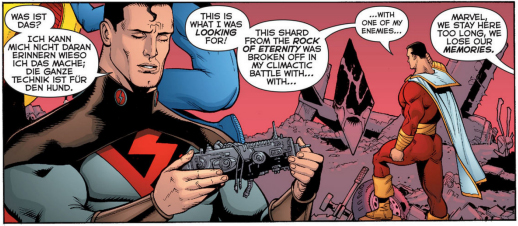
Batman, meanwhile, gets captured and strapped into a machine that allows some glob monster to sift through his memories disguised as Alfred to, I think, create an army of infinite Batman clones?
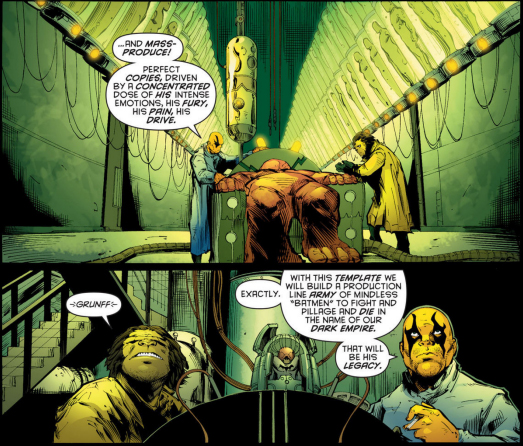
As they dig through his head, we're shown a montage of Batman in different costumes driving different kinds of Batmobiles while fighting different versions of his rogues' gallery. I admit, I don't understand what these two henchmen's literal plan is, but I get that it's a metaphor for the many variations of Batman that have cropped up through the years. His captors mention something about implanting false memories while they extract the real ones, including ones where Batman's parents were never killed and he became a doctor instead of a masked vigilante. But that's the point of this montage, isn't it. All these memories are real, just in different timelines. All versions of Batman are equally valid.
And just as the Superman tie-in story makes a callback to Animal Man with Comic Book Limbo, the Batman tie-in story makes a callback to Arkham Asylum. There, Ruth Adams made an observation on the Joker constantly recreating himself.
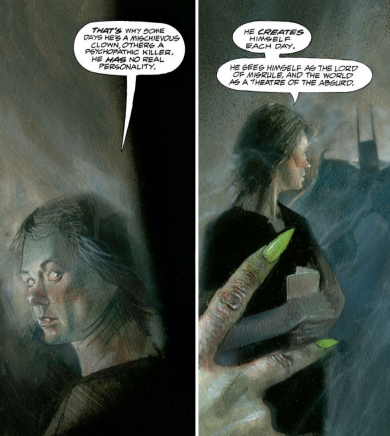
19 years is quite the long game, isn't it.

When I first read that I had a total brain fart and thought Batman was talking about himself. It still works, though; just as the Joker regularly reimagines himself, Batman too is being regularly reshaped by the ever-shifting waters of the Dreamtime. Is Batman a goofball, campily riding a bicycle with Superman or running around with a cartoon bomb? Is he relatively serious but not completely miserable? Does Superman regularly haul him to Japan so they can both gush over Japanese cuisine? (Oh, what's that? You think I making that up?) Or is he whatever the fuck Frank Miller was doing in All-Star Batman and Robin? Does he look like Adam West, or Michael Keaton? Or George Clooney, Christian Bale, or Ben Affleck?
Yes.
Deltarune's light world is populated by alternate versions of the Undertale cast as different from their Undertale counterparts as the Superman of the Fleischer cartoons is from the Superman of Batman v. Superman: Dawn of Justice. Only Fox could tell you if he got the idea specifically from Final Crisis, but it's still the same principle.
And how about the wildly different versions of its own cast? I'm counting six canon Spamtons, the ones who...
... got beaten up in the alleyway.
... made the deal with Kris, then were forgotten about in their shops.
... got put on the NEO Machine's disc, then left in Kris' pocket.
... were turned into Spamton NEO, THEN beaten up.
... were turned into Spamton NEO and aided by the kids (well, an attempt was made, at least).
... helped turn the Cyber World into a frozen wasteland and had his own scheme to take over the ruins blow up in his face.
Then the fanon Dreamtime got its hands on him and out came baby salesman.
According to The British Invasion, Final Crisis along with a divisive X-Men run where Morrison turned Magneto back into a straight-up bad guy after years of Magneto being slowly worked into a sympathetic anti-villain or even an anti-hero got Morrison chased off the Internet by death threats and general bile, with one reader declaring Morrison will one day see "justice" for what they did to Superman and Batman. How anything Morrison did here is worse than All-Star Batman and Robin is beyond me. Even today Grant Morrison maintains only the barest online presence.
Okay, there seems to be some confusion as to which Batman story got Morrison run off the Internet. The British Invasion says it was Final Crisis, but Supergods says it was Batman: R.I.P. Given the other mistakes Carpenter makes in The British Invasion I'm more inclined to believe Morrison, but here the confusion may have an explanation. The Final Crisis Batman tie-in story with the Clayface lookalike, "The Butler Did it," is also printed in Batman: R.I.P. or at least the version I picked up, so technically both books have the moment that set off the fanbase.
Heck, it was probably both of them and Morrison's handling of Magneto (although I'd be pretty miffed if I witnessed a genocide, and Magneto going bad again had its own twist) that created a trifecta of fan outrage. Again, Batman: R.I.P. hardly did Batman dirtier than All-Star Batman and Robin but maybe people give that a pass because of how unintentionally hilarious it is. I just hope people have chilled out over the years.
Anyway, Batman: R.I.P. centers around this band of villains called the Black Glove, a Devil-worshiping cult led by one Dr. Hurt, teaming up with the Joker to throw a grand "Let's kill Batman" gala. By passing off as a psychologist trying to help Bruce, Hurt implanted the phrase "Zur-En-Arrh" as a killswitch on Bruce's mind and decides now's as good a time as any to activate it. Think of it like the passphrase in The Winter Soldier that turns Bucky kill-crazy, only here the phrase was supposed to brick Batman. Unbeknownst to him, Bruce had planned for something like this.

Like booting a computer into safe mode after a major error, Dr. Hurt's attempt to destroy Batman's mind instead turns him into the Batman of Zur-En-Arrh, a persona Bruce created to run if he ever "crashed."

Okay, so what the hell is "Zur-En-Arrh"? Way back in the 50s Batman traveled to a planet called Zur-En-Arrh where the atmosphere basically turned him into Superman. And on that planet was this scientist who watched Bruce's adventures from across space and was inspired to become, well, the Batman of Zur-En-Arrh.
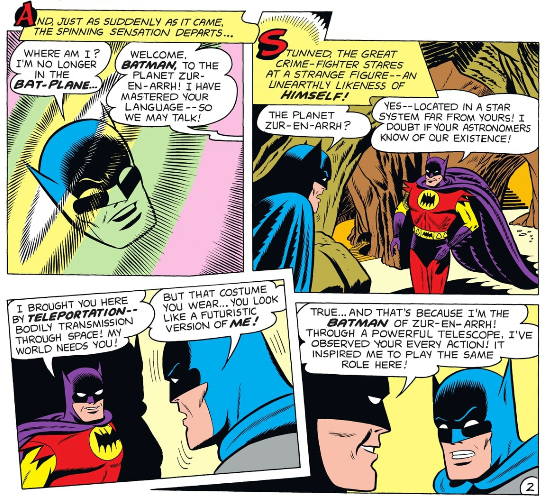
Because everybody was just throwing shit at the wall during the Silver Age.
Why did Morrison bring this Batman back for this story instead of, say, Zebra Batman? You'd have to ask Morrison, but Bruce's parents were killed as they were leaving the theater after seeing The Mark of Zorro, and just before Joe Chill opened fire his father told Bruce that Gotham City would "throw someone like Zorro in Arkham." Morrison seems to be retconning "Zur-En-Arrh" into a play on "Zorro in Arkham."
The original Batman of Zur-En-Arrh was a fanboy from another planet, but this Batman of Zur-En-Arrh is a violent whackjob who's somehow still not as psychotic as the Goddamn Batman of All-Star Batman and Robin. This Batman of Zur-En-Arrh is Batman without restraint or control. Batman without Bruce. Batman without his soul.
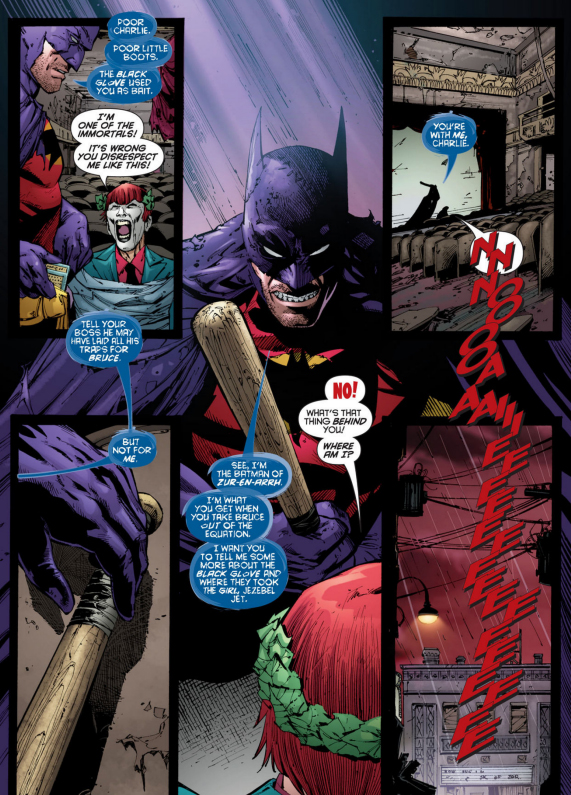
Just like how, without the SOUL, Kris becomes a violent, tire-slashing... *checks notes* pie thief who can only run on the programming scripts Fox wrote for them.
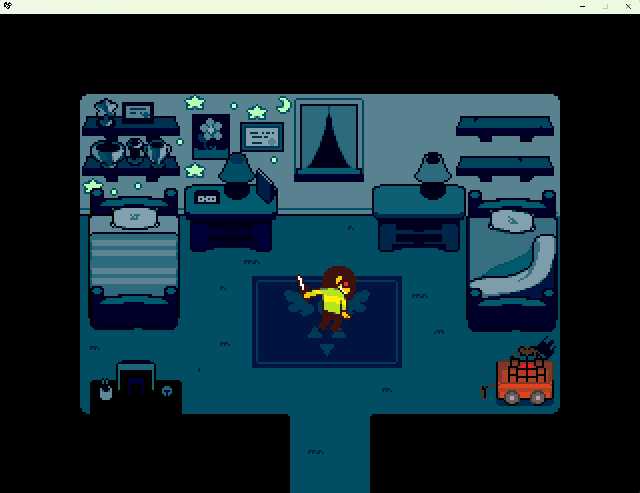
Next question! What the hell is that imp floating over Batman in the splash page, cosplaying as him? That's Bat-Mite, although this book spells it Bat-Might for whatever reason, a reality-warping imp from the fifth dimension like Mr. Mxyzptlk. For a while he hangs out with Batman to be his last shred of reason, but once they get to Arkham Bat-Mite is unable to enter with him because, as we established way back in Arkham Asylum, to enter Arkham is the pass through the doors of madness. Batman asks Bat-Mite one last question before entering, and gets the answer you'd expect from Grant Morrison.

Since you're probably asking questions after reading the words "imp from the fifth dimension," no, Mr. Mxyzptlk and Bat-Mite are not based on the fifth dimensional space aliens that allegedly abducted Morrison in Kathmandu and write our universe, they existed long before Morrison worked with DC. Morrison may be using Bat-Mite as an analogy for their fifth-dimensional aliens here, but otherwise it's a coincidence.
And going back to the discussion on apophenia, yes, soulless Batman looking over his shoulder at Bat-Mite while holding a baseball bat looks like soulless Kris looking over their shoulder at the player while holding a knife. Again, I don't want to call out every single panel of a Morrison comic that looks like something from Deltarune for fear of devolving into "Pumbaa was based on some random-ass warthog that appeared in a single episode of Kimba the White Lion" bullshit. So you might notice something I don't talk about and ask "How did you not notice this??" The answer is, I might have but decided it was too vague to be anything more than apophenia, which means I may pass over things that actually have something going on. In some cases, I skip talking about something because it's way too spoilery, like another key moment involving Joe's front door at the end of Joe the Barbarian. And some things may have just slipped through the cracks because holy shit, I'm finding so much.
Likewise, Batman: R.I.P. keeps mentioning the Joker alongside the Devil, calling back to the villains being the Joker and a cult of Devil worshipers.

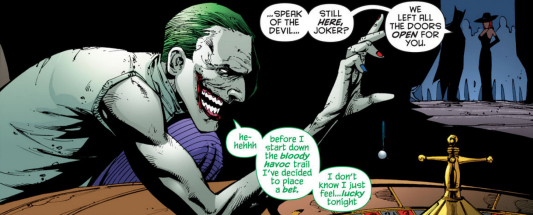
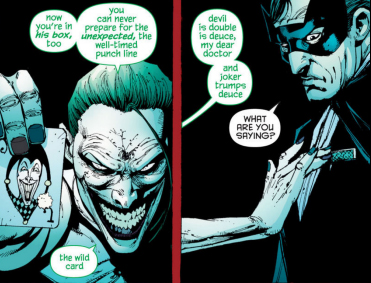
Can't say for sure this is where Fox got the idea for his own Joker-Devil, but given all the other weird parallels with Morrison's books I can't help but wonder. Also, I'll talk more about the frequent use of tarot cards in Morrison's books later in this article, but from what I've read the Joker card is not equivalent to the Devil card in tarot but rather the Fool, I guess because of luck, improvisation, and putting your faith in the whims of the universe.
Appropriately enough, the comic itself talks about apophenia.


At this point, I've spent so long in the asylum that is Grant Morrison's head that I'm starting to wonder if any of this makes sense.
Alright, I can't dance around that big moment from Final Crisis that angered the fanbase any more, but it's shown on the cover of Final Crisis trades anyway: Batman dies. After breaking out of the memory extraction machine, Batman confronts Darkseid and shoots him with a bullet designed to kill gods - in fact, Darkseid used the very same bullet to kill the New God, Orion - critically wounding him just before being killed by Darkseid's Omega Sanction. As you can imagine, fans lost their shit, calling Batman's death anticlimactic, pointless, and cheap.

He died taking down a god, you dumbasses.
You'd think they'd be angrier about Batman using a gun, but maybe they accepted that stopping the reality-destroying god was more important than Batman's aversion to firearms. But it doesn't matter anyway because the Omega Sanction didn't really kill Bruce (the corpse Superman finds in Final Crisis was a fake, apparently) but wiped his memories and sent him hurtling through time. He doesn't remember who he is, but something is subconsciously driving him to return to his original time, one time-jump at a time. Only problem is, the Omega Sanction also turned him into a magnet for something called Omega Radiation (lol "radiation") and if he reaches his original time period, the buildup of Omega Radiation will destroy reality in a calamity known as the All-Over.
That's the surface-level story, anyway, but the deeper purpose of The Return of Bruce Wayne is a further exploration of the idea presented back in "The Butler Did It," that of Batman as an all-purpose mythical figure being constantly reimagined for different times. In our world he's been campy, he's been moody, he's been completely out of his gourd. But he can also be a pirate. Or an even more blatant Zorro knockoff. Or a witch hunter working alongside one, uh, Brother Malleus.

Yes, "Malleus" means "Hammer" but still, what the hell is going on?

A key symbol through The Return of Bruce Wayne is water, and as Morrison's books establish time and again water is symbolic of potential and creation. Highwater calls the Implicate Order, another name for the Dreamtime, a sea of potential, Caulder's Think Tank is a pool of water with the power to reshape reality, and the Bleedspace from Final Crisis and The Multiversity is DC canon's version of the Dreamtime.
Every time Batman changes time periods, water is somehow involved. A couple times the water is only shown in the background, in fact the very first shot of the book is some cavemen examining the rocket Batman traveled to the past in crashed into a coastline, but most of the time he travels through it. He leaves the stone age by jumping off a waterfall, vanishing into the water below...


... and surfacing in a swamp at the height of the witch trials (yeah, uh, I think you skipped a few millennia there, Bruce), being hunted by a shoggoth.
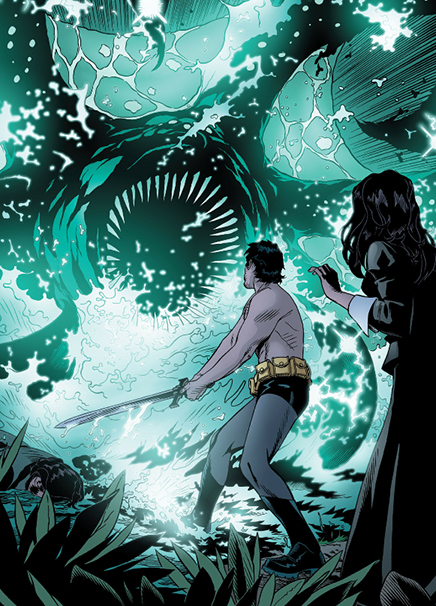
During a rematch with the shoggoth, he jumps into a waterfall...

... surfaces off the coast a couple decades later during a pirate raid...
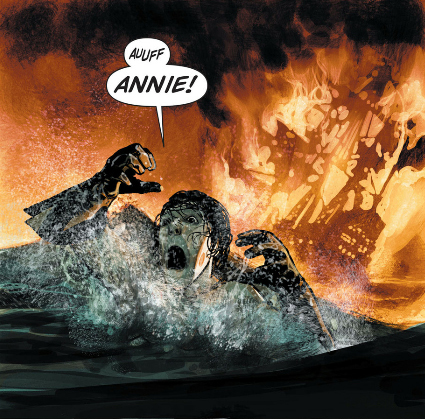
... and is promptly taken prisoner by Blackbeard. After leaving through another implied water shot, he appears in the wild west during a rainstorm...
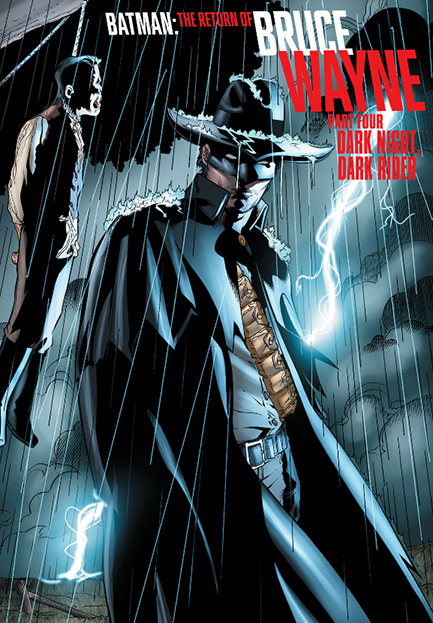
... falls off a pier after getting shot by Jonah Hex...
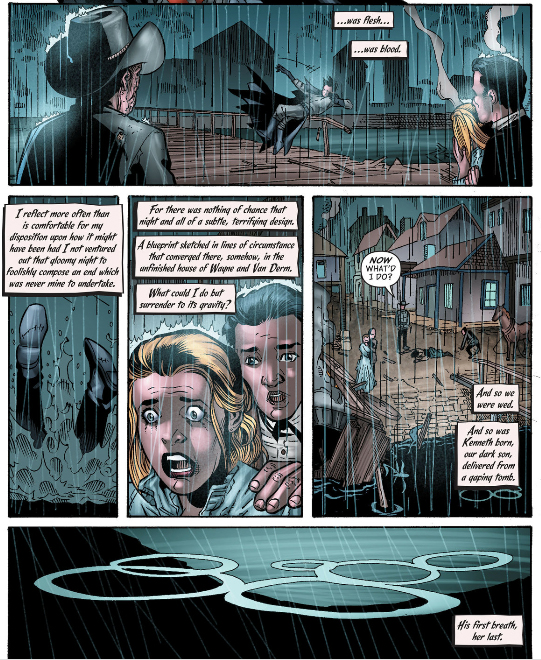
... and emerges from an alleyway on a rainy prohibition-era Gotham City night.

This time period feels like Batman coming full circle, back to his early adventures of beating up gangsters in suits.
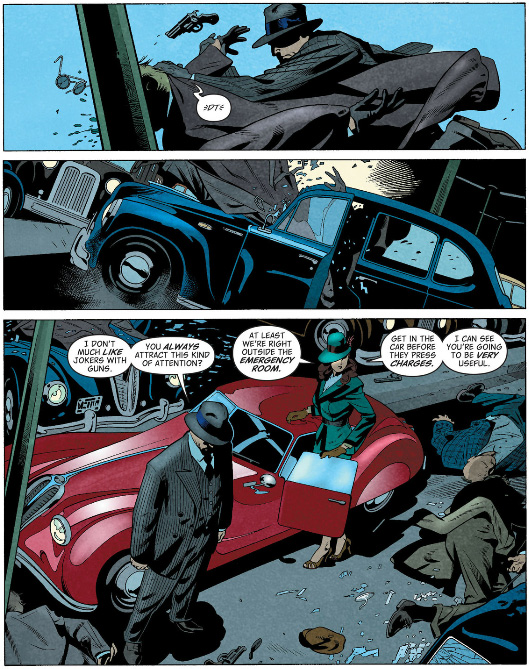
But we can tell what's really going on here: Bruce is falling into the Dreamtime, being reshaped by it, and emerging as a character simultaneously the same and different, over and over. Just like he is in real life every time a new writer or editorial staff takes over his life.
I'd like to take a moment to, again, remind everyone that one of Batman's monikers is "the Dark Knight."
Just like Batman: The Return of Bruce Wayne, water is a key symbol in Deltarune. The Dark Worlds are created by fountains, and while I believe this reality-creating force taking the form of a pillar of darkness was based on the Shadow Geysers from Magi Nation, the Dark Worlds are still being formed from a water analogue.

The background on the vessel creator is a distorted image of the ocean.

If you find Onion-san in Chapter 1 then talk to him again in Chapter 2, he'll say something about hearing a song under the sea.
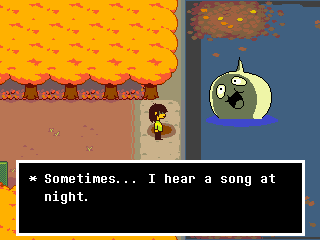
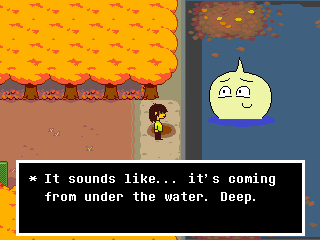
And the Roaring is a calamity in which the world is consumed by a flood of creative potential.

Meanwhile, the Justice League is trying their damnedest to catch Bruce slipping through the time streams before he brings that Omega Radiation bomb with him to the present. They even travel to the end of time, seeking the aid of this... uh, shadowy, horned cyclops thing...
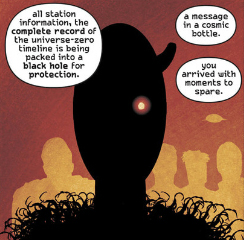
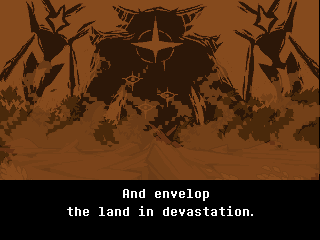
What the hell is going on?
Despite the Justice League's attempts to catch him, the titular return of Bruce Wayne occurs and they have to deal with the Omega Radiation some other way before it tears reality apart. Problem is, the only way to drain the Omega Radiation from Bruce is to kill him.
So they kill him.
I don't know how they do it because after Wonder Woman announces Batman has to die, Bruce hallucinates for a couple pages and then it just cuts to Superman and Wonder Woman with his body in a vat of water. I guess they drowned him, but his nose is above water in that panel and he's supposedly already been dead for two minutes, so it seems like they killed him and are now submerging him into the tank? But whatever, getting the Omega Radiation out of him somehow involves putting him underwater.

Once the Omega Radiation is purged, Superman and Wonder Woman resuscitate Bruce and he, one last time, emerges from water reformed. Not as a caveman, not as an old-timey private investigator, but as Batman.
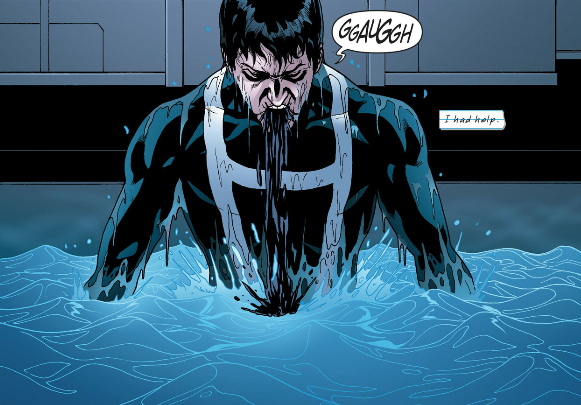
While I argue that all the water in Deltarune represents the Dreamtime, some fans take it to mean Kris drowned. They turn blue in the Dark World which is a symptom of drowning, although I think they turn blue because, as I mentioned back when I was talking about the cover of We3, the Fun Gang's color scheme is based on the primary colors of additive colors, and Susie got red while Ralsei got green, leaving Kris with blue. And maybe Fox gave Kris blue instead of green because water is also blue, and our [Little Sponge] is connected to water. But if Kris - who, by the way, turns into a knight in the Dark World - did drown and was changed when pulled from the water and resuscitated... seriously, what the hell is going on?
I guess it's fitting that the last book I'm touching on is one of Morrison's first books.
Zenith is a bit of an outlier in this project for a few reasons. For starters, it's the only Morrison book I'm covering in-depth that wasn't published by DC or their Vertigo line; it was published in 2000 AD, the same comic anthology magazine that published Judge Dredd (yes, New X-Men was published by Marvel and Klaus Boom Studios, but I only mentioned them in passing). It's also the only book that I didn't purchase or borrow digital versions of, so I have to scan the physical books. Finally, most of it is in black and white.
Zenith is another late 80s superhero deconstruction, a genre popularized by Watchmen, Marvelman/Miracleman, The Killing Joke, and The Dark Knight Returns just in case you thought Alan Moore had a monopoly on the genre. A major difference is Zenith himself isn't outright malicious, he's just waaaay up his own ass. He doesn't want to save or conquer the world, he just wants to drink and party and fuck and use his superpowers to further his music career. In fact, he barely does anything in the second half of the story, and two other characters save the day in the third and fourth volumes. Maybe that was the joke: the title character isn't even the hero of his own story.
You're probably looking at the dates up there and thinking, damn, six years? That's longer than Doom Patrol! Well, Zenith didn't run consecutively from '87 to '92. The story is broken up into four major storylines, called Phases, and when a Phase was done the comic would go hiatus for anywhere from several months to two whole years until the next Phase started up. Chapters published weekly but are pretty short, most only being five pages with prologue chapters being longer, so you get slightly under a monthly book's 25 pages. All in all, the whole series is about 400 pages, maybe 450 if you include the art galleries.
The story of Zenith starts all the way back in World War II with the Allies creating a superhuman soldier, Maximan, and the Nazis creating their own, Masterman. The two inevitably clashed, as superheroes and supervillains do, and Maximan got his butt kicked. With Masterman on the cusp of victory, the Allies nuked Berlin, killing them both.
With Maximan lost, Dr. Michael Peyne used the remaining superhuman serum to create an entire team of superhumans he called tygers. Most were a success, but a couple didn't turn out as planned.
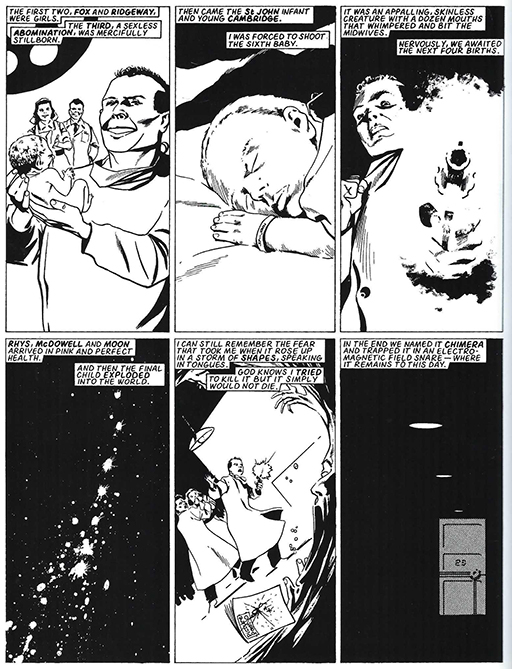
And thus Britain's superhero team, Cloud 9, was created. Even though there's only seven of them. And yes, I know "Cloud Nine" is a thing, and maybe "Cloud 9" sounds cooler than "Lucky 7." Well, over the years four of the members - White Heat, Lux, Spook, and Dr. Beat - have either died or gone missing, leaving only the psychic Peter St. John aka Mandala, the pyrokinetic Siadwell Rhys aka Red Dragon, and the electrokinetic To... 'scuse me, Ruby Fox, aka Voltage.

I already talked about how her name just means "red fox" but it gets weirder. Up to now I've been dancing around Toby Fox's old Internet handle because I don't know if he's embarrassed by or actively hates it (not sure why he would, it's not like he went by "Xx_DemonSword666_xX" or "Cuntsmasher420" or something) or if he acknowledges he used to go by it and just doesn't want to be called it anymore, but it was "Radiation." Voltage and radiation are both linked to electromagnetism (tldr, voltage is the fuel for an electromagnetic circuit, radiation is the product, and when the voltage increases so does the radiation. That's a very simplified way of putting it but I think it gets the point across), and are both types of energy generated by nuclear power plants.
So the day after I initially uploaded this, I found out Toby Fox's real name is not Tobias as I'd thought all these years; it's Robert. And Zenith's real name is Robert McDowell. What the shit is going on.
But Masterman was more than a sentient weapon for the Nazis. In a higher plane of reality lie the Many-Angled Ones, the Dark Gods, the Lloigor, the Great Old Ones, or whatever else you decide to call this comic's take on the god-like aliens from the Cthulhu mythos. They want Earth but in order to function in and influence the lower reality, they need specially crated vessels to inhabit.
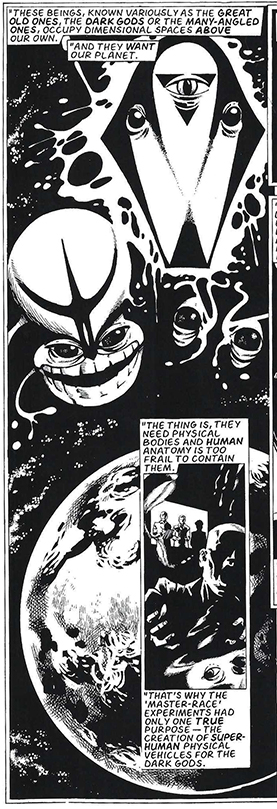
You know, the same way we need a vessel to function in Deltarune, and were supposed to get our own custom one until somebody *cough*Toby Fox*cough* shoved us into Kris.

As of the 80s, the three surviving members of Cloud 9 have all retired from the superhero gig and integrated into society; Ruby became a newspaper editor, Peter a politician, and a Siadwell a... drunkard? But they're forced back into action when a Masterman clone appears possessed by the Lloigor Iok Sotot (which is another name for Yog-Sothoth), and Ruby goes looking for Zenith, the son of Cloud 9 members Dr. Beat and White Heat. Long story short, Siadwell dies in the fight, Zenith kills the Masterman vessel, Peter sends Iok Sotot back to its plane of reality, and Ruby takes off to an alternate reality. More on that last bit later.
Zenith's popularity explodes after his fight with Masterman and the next few months are just him back to his hedonistic self, until a war mech smashes his flat.
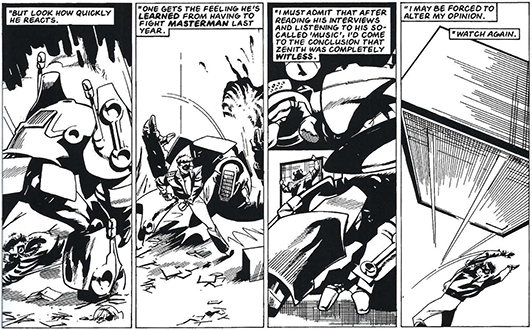
Zenith is saved when a CIA agent, Phadrea Cale, uses flashing lights to give the mech a seizure, forcing whoever sent it to recall it. Cale is there because the tygers' creator, Dr. Peyne, has teamed up with a computer engineer named Scott Wallace to highjack a submarine and launch nuclear missiles at London, something something, world domination? The mech, Warhead, was sent to deal with Zenith as Peyne believed he was the only threat to his plan.
Now wait, how could flashing lights give a robot a seizure? Hmm...
Meanwhile, Peter St. John has a vision of a ruined future, with a black sun looming over it all.
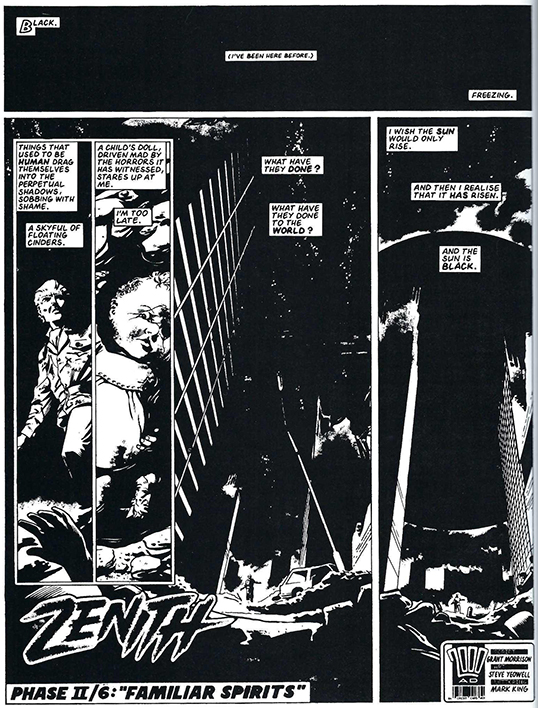
Like he's having a prophecy about the world being plunged into eternal darkness.
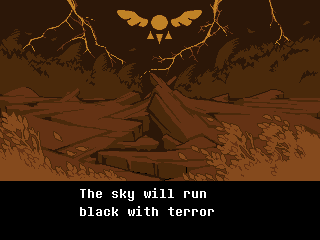

Zenith and Phaedra infiltrate Peyne's old lab where he and Wallace are hiding out, but are soon captured and Phaedra is executed. Peyne takes Zenith aside and reveals his parents were attacked by the CIA's special, anti-superhuman force known as the Shadowmen, who killed his mother and left his father severely brain damaged.

Shadowmen.
Okay, so Deltarune's September 2022 update includes a .gif of a band made up of Tasque Manager, K_K, Sweet, and a Mr. Nobody-esque silhouette man playing a saxophone.

At first I thought that character wasn't literally supposed to be a silhouette and that he'd just been censored out. But the Spamton Charity Auction revealed, no, he is actually a silhouette and is just one of several similar enemies called Shadowmen.
By the way, you pacify the Shadowmen by literally knocking their socks off (click the image in that link, it's actually a video), and Mr. Nobody wears gloves.
Anyway, just when you think the day couldn't get shittier for Zenith, his father is the one inside Warhead. Peyne orders Warhead to kill Zenith, and during the fight he destroys a familiar looking cell.

Again to make a long story short, Zenith puts his father out of his misery, stops the nukes, and is ready to leave the day behind him. Back at his flat he meets up with his agent, Eddie, and tells him what happened. But then Eddie calls him on the phone and... wait, then who the hell is in the room with him?
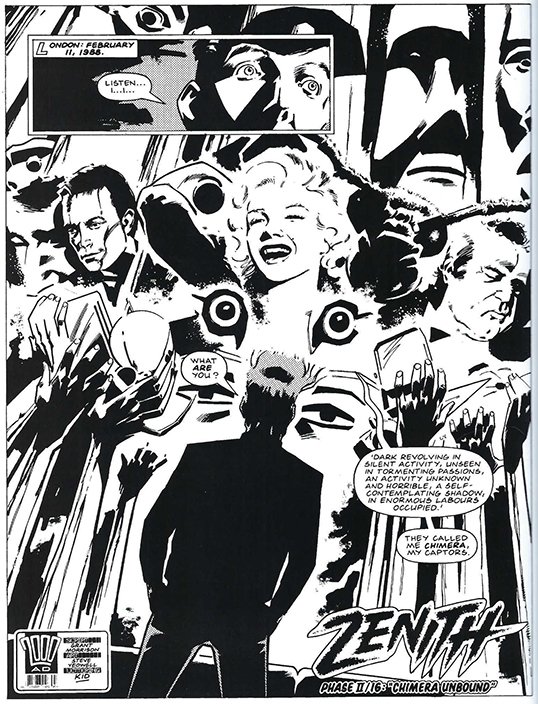
Chimera is being of pure thought and can assume any shape it desires. But Chimera doesn't desire any one shape; it wants to experience all shapes, all sensations, all feelings, all at once, and starts taking on vaster and vaster forms until finally turning into a crystal pyramid.
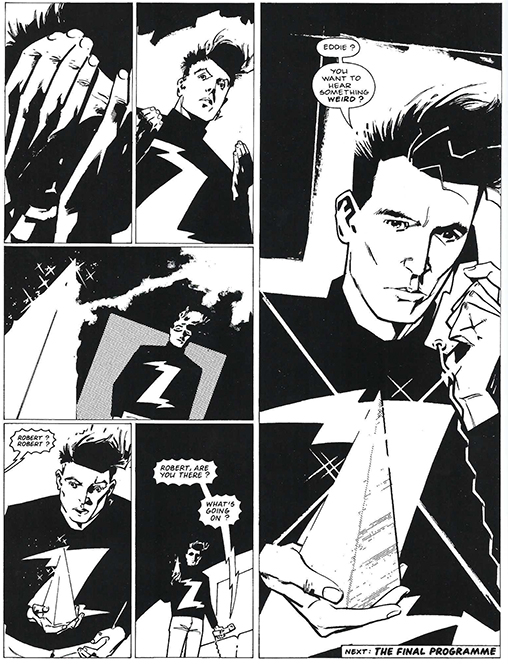
Uh, did Zenith just obtain a Shadow Crystal? He even gets it from a shapeshifter who was imprisoned in the basement of the big bad's hideout, and was muttering about freedom earlier.
So what is this crystal? An entire universe within the universe, simultaneously containing all creation and being a part of creation, not unlike that fractal bird from Animal Man.

It's actually pretty interesting to read Zenith and see how many of the Morrison tropes present in their later work were there from the start. In Final Crisis, Zillo Valla compares worlds forming within Bleed to crystals forming in a solution.
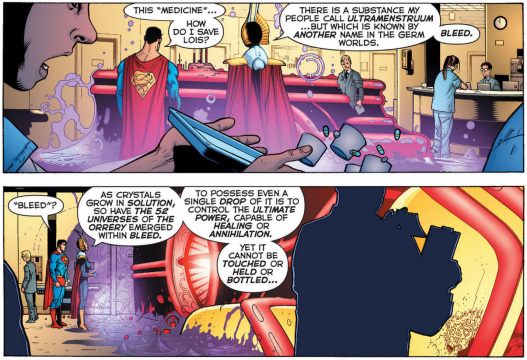
So, for kids who never made rock candy in school, you create a solution by dissolving sugar in boiling water until the water is super-saturated, then place a stick or piece of string into the water. Cold water can't hold as much sugar as hot, so as the solution cools the sugar crystallizes onto the string or stick (this is why rock candy you buy at the store usually comes on a stick or has a piece of string in it. If it doesn't that means it was smashed off the stick/string afterward, so the crystals will be smaller). In that same sense, worlds are crystals formed within the solution of the Dreamtime.
And the spirits that turn Klaus into Father Christmas take the form of crystal polygons, what one might call "Many-Angled ones" (the Klaus ones are benevolent, though).

There's something weird going on with the runes there, but I'll save it for the Miscellany section.
And what's another common Morrison trope? That's right, alternate realities! Phase 3 is a... parody? of Crisis on Infinite Earths and Secret Wars, in which an alternate universe Maximan who survived the nuking of Berlin gathers superhumans from across the multiverse (including Zenith's more modest counterpart, Vertex) to Axis Mundi, his hideout on Alternative 23, to stop another plan by the Lloigor to take over their worlds. The alternates are all floating around each other like, well, particles in a solution, I suppose, and will soon align in a precise way to form a crystal-like structure known as the "Omnihedron." The Lloigor usually need special vessels to function on Earth, but if the Omnihedron forms it'll open a direct gateway between their worlds and the plane of the Lloigor.

Two alternatives, 666 and 257, have already been ravaged by the Lloigor possessing their superhumans. The solution? Destroy these two worlds with Chaostructors, devices that open holes to the Chaoetheric and send them back to the chaos from which they spawned. Not only will it stop the Lloigor from being able to infect other worlds through these two, it'll create a flaw in the alignment of the worlds and stop the Omnihedron from forming.
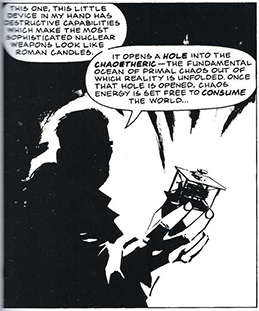
Basically, the Chaoetheric is Zenith's name for the Dreamtime. Yeah, Morrison really likes the "overabundance of chaos and creative energies destroying the world" trope: the second Crisis in Animal Man, the Think Tank in Doom Patrol, the Omega Radiation in The Return of Bruce Wayne, even Kid Eternity has these demons (fallen angels?) creating the "Chaosphere Engines" with the intent of recreating the world, now this.
Speaking of which, what will happen in Deltaune if too many openings are made into and too much potential allowed to pour out the Dreamtime?

The superhumans split into two groups, each taking an Alternative, and after numerous casualties successfully wipe out the two worlds. But there's a twist: Maximan has been working for the Lloigor all this time, and destroying Alternatives 666 and 257 didn't introduce a flaw into to alignment of the worlds, it corrected one. Now the worlds are aligned for the Lloigor's invasion and if he destroys Alternative 230 - Zenith's Alternative - with a third Chaostructor it'll make the Omnihedron resonate at the right frequency to make the Lloigor's invasion even easier.

Yes, this is eerily similar to the Veil digging out his own eyes with a spoon and still seeing the truth about the higher reality, but literally blinding yourself to see the metaphorical truth is a common trope.
Maximan begins his ascent to the plane of the Lloigor in an pillar of light, to the infinity beyond their reality he calls "Point Zenith."
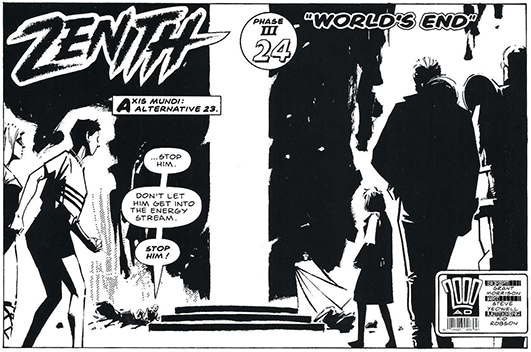
Also, the chapter is called "World's End."


Using the Chaostructor that was meant to destroy Alternative 230, Vertex sacrifices himself to destroy Alternative 23, both interrupting the Lloigor's invasion and disrupting the Omnihedron.
Zenith's final Phase is in color, though I don't know if 2000 AD as a whole had moved to color or they wanted to do something special for Zenith's final story arc. Anyway, the superhumans - including Lux and Spook who faked their deaths to hide in other Alternatives, clones of Ruby and White Heat, and what I believe are refugees from other Alternatives - have all decided that if they were born to be gods, they're just going to own it, ascend to godhood, and make the world their bitch. They offer Peter St. John and Zenith a chance to ascend with them, but both turn it down.
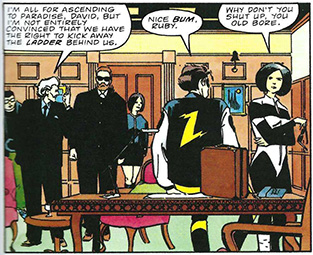
Unfortunately, Ruby finds Chimera and destroys it, so when the Shadowmen attack another superhuman and trigger a war between humans and superhumans, Zenith and Peter don't have their trump card. They try to fight anyway but are outnumbered and are forced to retreat into a psychic wormhole. Only problem is Peter made it in a hurry and has no idea where - or rather when - it leads to. And wouldn't you know, it takes them straight to the ruined future Peter envisioned back in Phase 2. Now in color!
While they were away, the tygers wiped out all life on Earth by knocking the Earth off its axis (except for Dr. Peyne as a reward for creating them), conjured the Black Sun, and in a dark variation of the sun metaphor Morrison would later use in All-Star Superman flew up into it to begin their ascension to godhood.
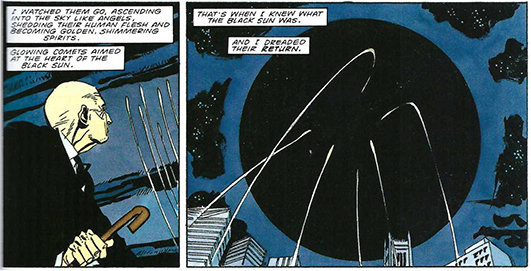
Take note of Peyne comparing the tygers to angels.
Zenith and Peter showed up just in time to watch them hatch, and they don't stand a chance. Zenith gets eaten by his own infant son, now the vessel for Iok Sotot, and Ruby Fox turns into Parallax and absolutely hands Peter his ass.
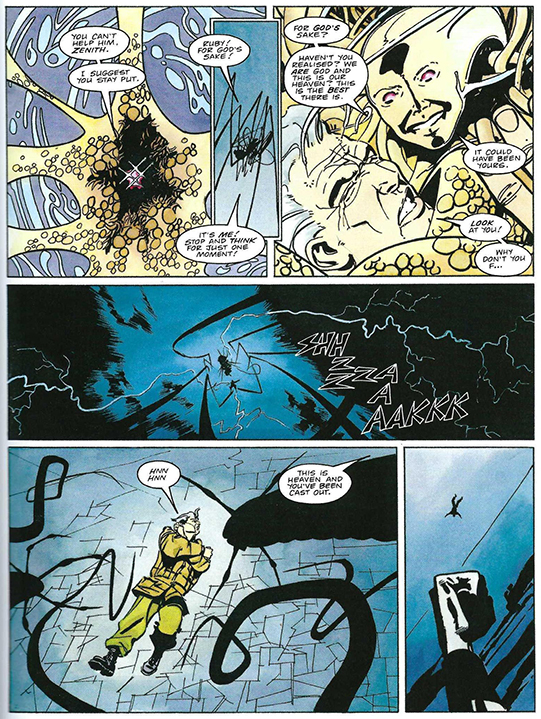
So the tygers have becomes angels, and a world consumed in darkness is their Heaven.
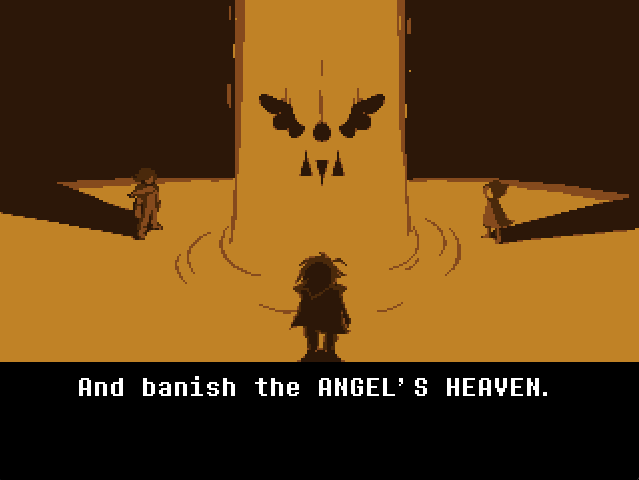
For a while the Lloigor smash their toys around, shaping and reshaping human corpses like piles of clay, destroying cities and rebuilding them just to knock them down again, causing natural disasters like a bored Sim City player, and changing the very makeup of the planet. But they finally tire of the Earth and, looking for new playgrounds to defile, take off into space, ascending higher and higher until they reach...
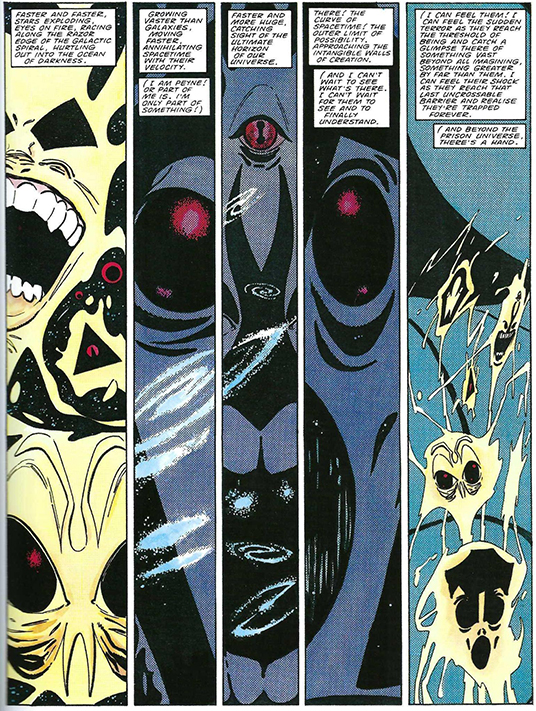
... a hand?
Yeah, all this time they've been imprisoned within the clone universe, Chimera.
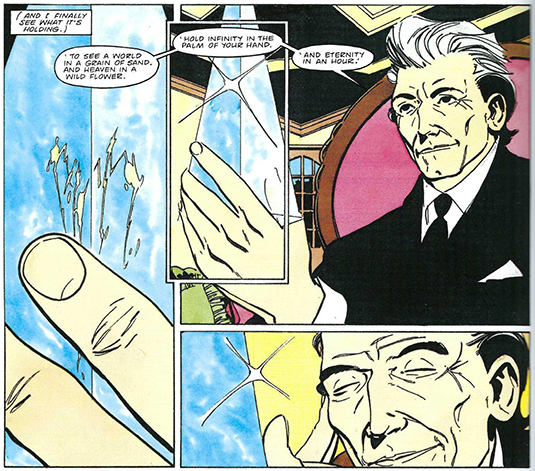
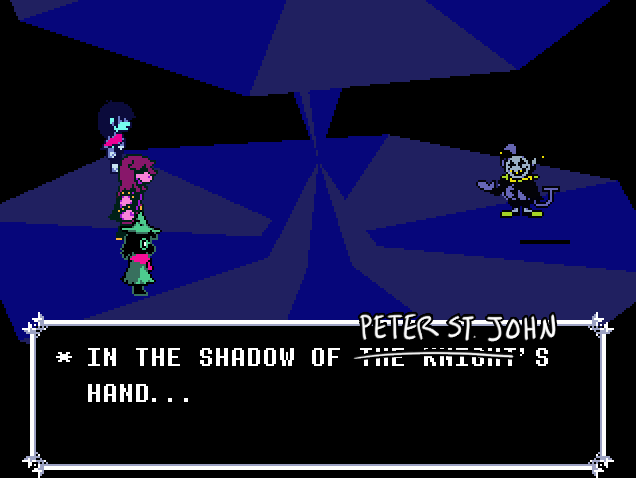
That flash where Ruby Fox thought she was destroying Chimera was actually Peter St. John shoving her and her allies into Chimera. Then when they opened the door to the Lloigor's reality, it went between the Lloigor's reality and Chimera's reality so the Lloigor got pulled down two realities and are now forever imprisoned in a reality below the one they wanted. It's also reminiscent of the heroes of Flex Mentallo moving themselves into the reality beneath their own creation to survive as dreams, only they did it willingly to avoid extermination instead of being tricked.
If "banshing the Angel's Heaven" means Deltarune is going to end with the main characters combining the seven Shadow Crystals into one Pure Crystal then shoving our reality into it, making themselves the gods over us... in my opinion, our universe wouldn't be the only thing getting shoved into something. By which I refer to Toby Fox shoving the game up his own butt, but your mileage my vary.
Zenith ends with Zenith going back to his music career and Peter St. John winning an election after using his psychic powers to give his political rival, Labour Party leader John Smith, a fatal heart attack. The real-life John Smith would die of a heart attack on May 12, 1994. Guess we'll just have to wait and see if Deltarune predicts any deaths.
As a self-proclaimed chaos magician Morrison is very much familiar with tarot cards, and received their first deck as a kid from their uncle. Myself, before having to research this project I knew of several of the cards like Strength and The World through The Binding of Isaac and JoJo's Bizarre Adventure, but as far as what any of them meant, I only knew that Death can also mean change. Time to do some research.

The coloring book gives a summary of each card, while the deck includes a booklet that summarizes the cards, describes what they mean rightside up and upside down, and illustrates a few ways to lay them out and how the cards' locations affect each other.
During Doom Patrol's narration about the death of dreams, one of the cutaways is to a fortune teller reading the cards.

She appears to be holding the Seven of Swords (being direct instead of sneaky and rooting out somebody being deceptive), but it might be the Seven of Wands (enduring a long struggle alone or with others working against you) if those little shapes at top of the long parts are supposed to be headpieces instead of hilts. The Seven of Swords seems to fit the Candlemaker attacking the dream world under everyone's nose better, but I feel like she could be holding any card and I'd find a way to link it to what's going on in the story.
A major plot point of Arkham Asylum is that the psychiatrists at Arkham gave Two-Face a die, then a tarot deck to try to teach him some situations have more than two choices. And if you've ever wanted to read about Harvey Dent pissing on the floor like a naughty puppy for some reason, have I got a comic for you!

The Tower symbolizes danger, upheaval, destruction, and liberation, hence why it spawns a bunch of bombs in The Binding of Isaac. Reversed, it means, well, exactly what Ruth says there: tearing down in order to rebuild.
Instead of a fight against a roided out Joker, the comic ends with Batman giving Two-Face his coin back and Two-Face throwing away the cards, with the final panel being a shot of the Moon card.

The Moon card often shows a pair of towers leading up to the moon, but I don't know if the cards are related. This card also has a scarab beetle on it, a symbol of rebirth, and as anyone who's played Batman: Arkham Asylum knows, images of the scarab are all over the asylum.
Batman R.I.P. opens with the Joker seemingly playing solitaire but he's actually performing cartomancy, essentially using a standard playing card deck like tarot cards.
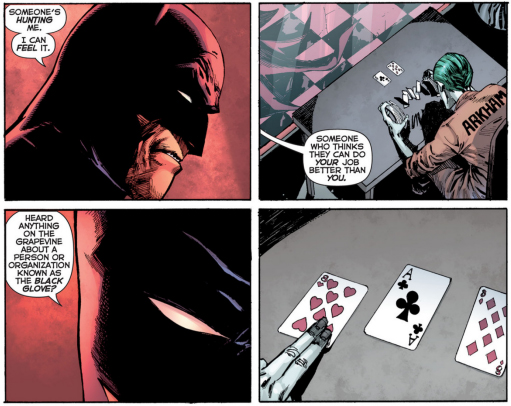
The Joker lays out cards numbered 8-1-8-1, which when converted to letters of the alphabet spell out "HAHA", and if we go by Spades as Swords, Hearts as Cups, Clubs as Wands, and Diamonds as Coins, the cards mean:
Eight of Cups - Persevering in the face of setbacks
Ace of Wands - Creation, invention, and rebirth
Eight of Coins - Practicing your skills
Ace of Swords - Gaining new understanding
On one hand, those do describe Batman, both in general and his arc through R.I.P, Final Crisis, and The Return of Bruce Wayne. On the other, we later learn the Joker was just throwing crap at the wall and letting Batman's apophenia do the rest.

Of course, from Batman's view they're all upside down (well, at least the Aces are, the Eights are pretty interchangeable, especially Diamonds) which changes their meaning.
Batman: The Return of Bruce Wayne has the Hanged Man which represents a bad situation giving you a chance to look at things from another view.
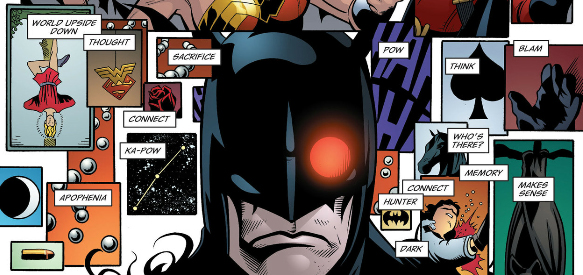
When King Mob is gearing up to go rescue Jack Frost in The Invisibles, Ragged Robin is behind him reading the cards.

She's focusing on the Moon, but the other two cards in the first panel appear to be the Seven of Cups and a Coin card. The one closest to her right elbow appears to a Cup, the two by her left wrist might be the Aces of Wands and Swords, but I really don't know what any of other cards are supposed to be.
Kid Eternity features the Wheel of Fortune, which symbolizes taking risks.
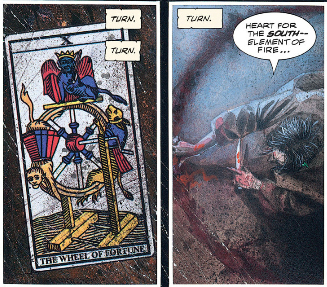
And when Ralph Dibny communes with Dr. Fate's helmet in 52 he receives a vision of various magic-users of the DC universe such as Zatanna, the Spectre, the demon Etrigan, and a few characters I don't know the names of. A ring of tarot cards (specifically, the Rider-Waite-Smith prints) are flying out of Zatanna's hat.

Interesting that the Death card has a knight on it. Also, the knight in that spacial tear thing with Etrigan is Nightmaster, a character Buddy runs into in Comic Book Limbo.
The cards themselves don't appear in all the books, but sometimes symbols from them do. Once again, the moon is a recurring symbol in Flex Mentallo and the Moon card represents dreams and the fantastic. And going back to the Moon card depicting towers leading up to it, there's a point where Wally ends up on the moon looking at the earth, with two stone structures on either side of it.
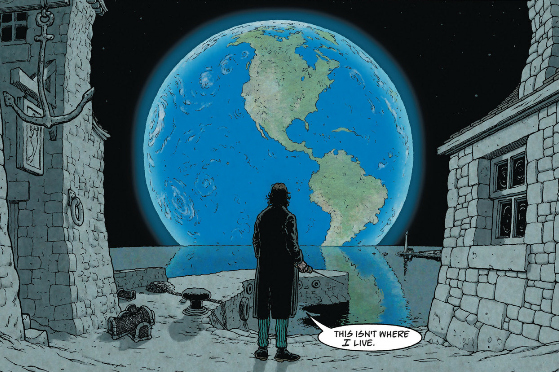
A key plot point of Joe the Barbarian is an upside-down picture of Joe's parents, which is reflected in the Iron Kingdom as an upside-down portrait of the Iron Knight with Queen Bree.
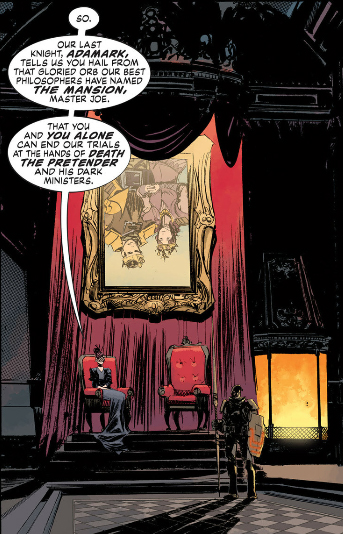
This could be another reference to the Hanged Man as Joe's hypoglycemic hallucination is literally changing his view of the world. It could also be the Lovers reversed, which represents a love that's cooled off, but not completely snuffed out. And yeah, Joseph Sr. and Bree's love has hit a rocky spot, you know, on account of Joseph Sr. being dead.
And during Morrison's New X-Men, Wolverine, Cyclops, and new character Fantomex infiltrate a bioweapon facility called The World.
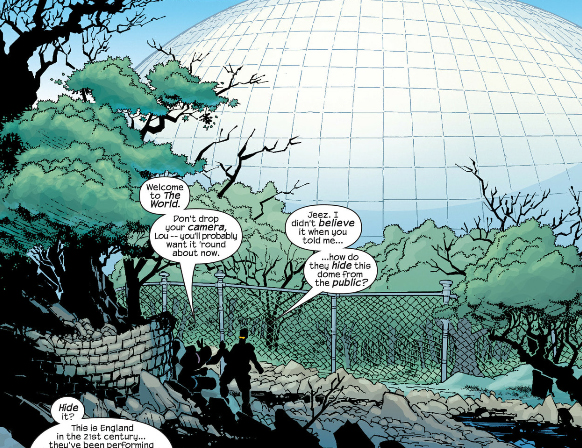
The World card symbolizes stability while surrounded by uncertainty and whether your adventure is ending or only just beginning, and The World is used to create bioweapons designed to eradicate mutants, which are set to replace humans so yeah, makes sense.
Fangamer sells a deck of Undertale-themed tarot cards, although it's not a proper tarot deck. It only has 36 cards while a normal tarot deck is 78, it duplicates four of the major arcana (for example, the kissing dogs and the Royal Guards are both the Lovers), and one of the cards, Jerry, isn't marked as anything so only 9 of the 56 minor arcana are covered, most of which are Swords. I always found it a bit odd that tarot cards were something somebody thought to put Undertale characters on since they, far as I know, have no role in the game.
Meanwhile, one of the rewards for the Hiveswap Kickstarter, starting at the $155 tier, was a deck of Homestuck-themed tarot cards. And I know next to nothing about Homestuck, so I don't know if tarot cards were a thing in the story.
At first, the only connection to tarot I saw in Deltarune was Catty mentioning Kris and her studying occult stuff together.
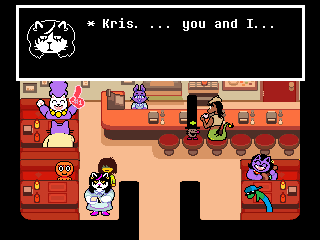

Which would surely include tarot cards. But the more I looked into tarot, the more connections I found in Deltarune.
Spades correspond to Swords in tarot, and Clubs Wands. The Rudinn enemies are based on Diamonds but they wield swords while the Hathy enemies are based on Hearts and wield wands. Meaning both are based on red suits, and wield the tarot weapons corresponding to the black suits.
Lanino and Elnina are holding wands.

Cat Tarot's booklet says the Two of Wands is about possibilities and opportunities and sorting them from distractions, while the coloring book says it's about progress towards your goals. I guess if these two are a reoccurring nuisance through Chapter 3, constantly derailing your quest to seal the Dark Fountain with bullshit sidequests then yeah, that would fit, but we won't know for sure until Chapter 3 releases.
The Queen of Cups demands respect but is not insensitive to the emotions of others, and is even capable of great compassion.
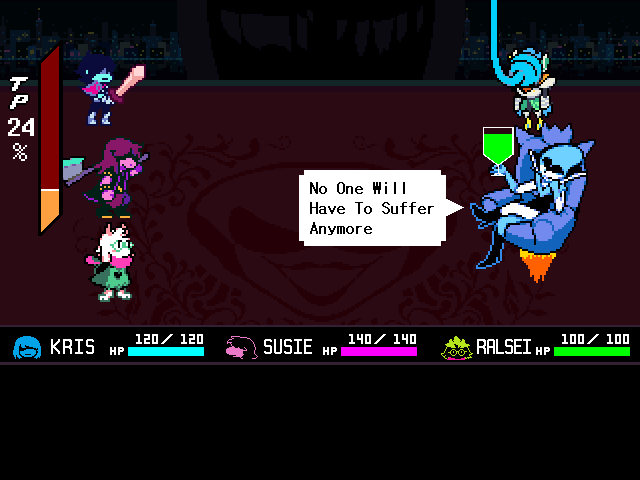
And the King of Swords reversed represents a loss of control and discipline and finally descent into chaos.

Huh.
As for the hidden bosses, my first choices for Jevil and Spamton were the Devil and the Hanged Man. And yeah, being in a bad situation giving you a new look on things does fit Spamton's life in a dumpster, but I'm starting to believe Fox had the World in mind for Jevil. He's the secret boss of the first chapter, and when you complete Chapter 1 it's not really the end, but only the beginning of the adventure. And his boss theme is "THE WORLD REVOLVING" which could be a reference to the World card turned upside down. Cat Tarot's booklet says an upright World means you're satisfied and to "let the wide world spin."
The Undertale tarot deck assigns Mettaton/Mettaton EX (which are one card) and Mettaton NEO to the Star, which symbolizes hope, regeneration, transformation, and turning your life around no matter how bad it gets. And yeah, that fits Spamton getting into the NEO machine. Maybe Spamton is the Hanged Man while Spamton NEO is the Star.
The other two cards the set duplicates are the Sun and the World, the Sun used for Grillby and the Monster Kid, and the World used for Stronger Monsters and Mt. Ebott. Yeah, you'd think it would have been both versions of Undyne, but Undyne is Justice and Undyne the Undying is the Chariot.
Cat Tarot's booklet and the coloring book both say the Devil is about desires but the booklet elaborates on being bound by your desires (the card itself is a dog on a leash. Also, the Steam trading cards for Binding of Isaac: Rebirth are tarot cards, and the Devil card depicts Satan with Eve and Judas in chains) while the coloring book talks about exploring your wants, understanding your shadow self, and taking care not to lose yourself to your desires. Depending on how they're laid out some cards influence others, so if the Devil is supposed to be about breaking free, I wonder if all the secret bosses are meant to be one of the major arcana influenced by the Devil.
Also, standard playing cards have have the jack, the queen, and the king for each suit, but the minor arcana in tarot has the page, the knight, the queen, and the king. From what I can gather the jack evolved from either the knight or the page, but is now considered its own thing. And if we combine cards and chess we get King, Queen, Jack, Bishop, Rook, Page, and Knight, seven titles for seven villains for seven chapters of Deltarune.
And if there is a book chapter and the main villain isn't a Page, Fox, what are you doing.
Okay, I don't entirely understand what people are going on about with eggs in Deltarune. Something about hidden eggs in the game, and when you type "EGG" into Wingdings it turns into fingers pointing in the way a Knight moves in chess, and Papyrus having an egg in Undertale and saying his favorite food is oatmeal with the dissolving dinosaur eggs in it, so this is why people think Papyrus is the Knight? The only eggs I was aware of were the one Temmie had during the group project and Spamton's Pipis, but apparently eggs are such a big deal in Deltarune they merit their own page on the Wiki.
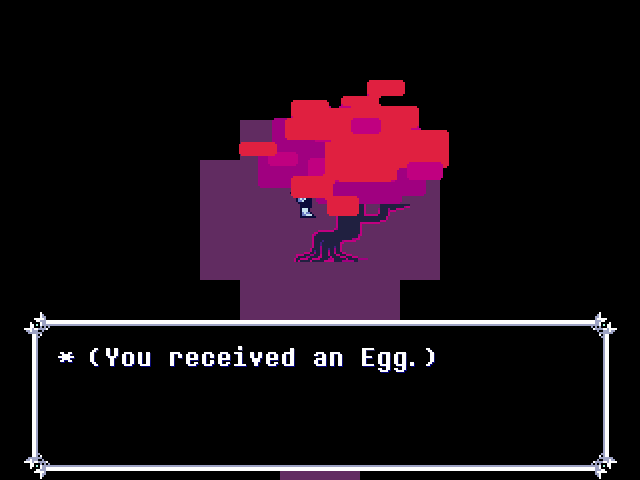
But would you like to guess where I have seen a few other eggs? Morrison's books.
Flex Mentallo opens with a bomb turning into the Big Bang turning into a galaxy turning into a Fact-shaped wax stamp on an egg that a cook is using to make an egg sandwich for Flex.
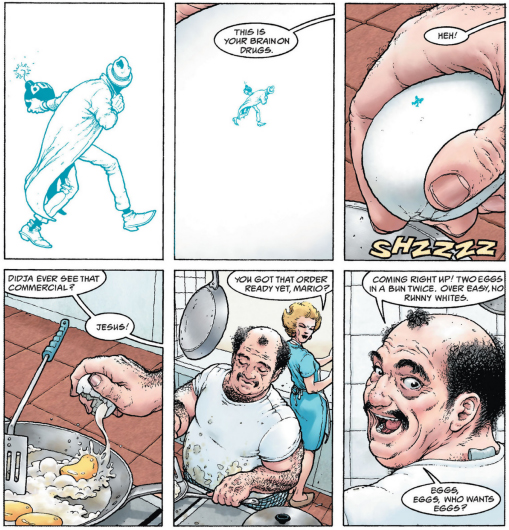
We already talked about Mr. Nobody getting the Doom Patrol to back off by threatening to shove an egg up a bystander's butt.

The Black Sun the superhumans use to become the Lloigor is both a door and an egg.

And as much as I want to avoid talking about The Multiversity, the most prominent of the Gentry is this Fernandez (or Fernandeath for the weebs) look-a-like called Intellectron, which plays a major role in the "cursed" issue.
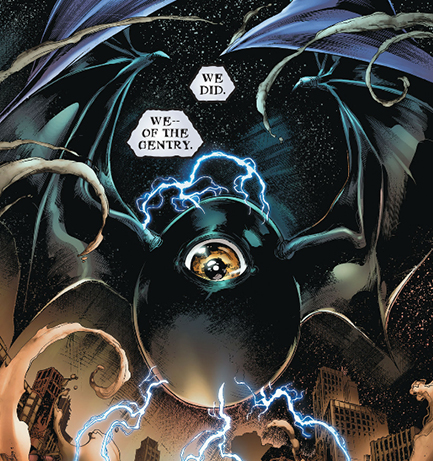
Through the power of metanarrative, Ultra Comics gets the people talking about the book on message boards to damage it by mocking it for looking like an egg.
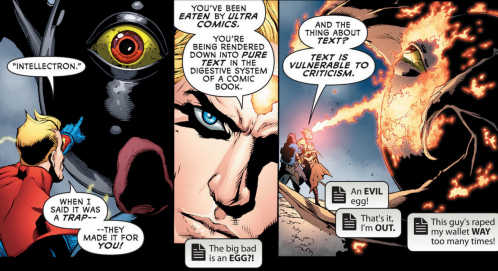
I think this is a reference to 52, where one of the plot lines was about mad scientists from across the DC universe being kidnapped and brought to an island where they built weapons for a giant egg.
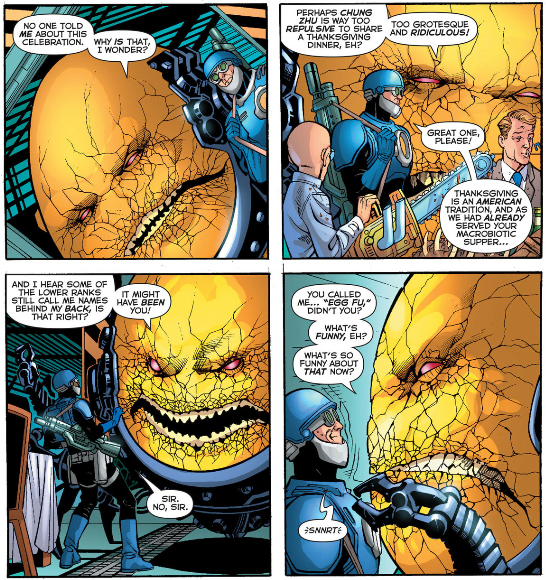
So what's the deal with eggs? Maybe eggs, like water, represent unknown potential. Sure, you can probably tell if an egg belongs to a bird or a reptile as bird eggs have hard shells while reptile eggs are leathery, but if you're not a professional, it's hard to tell what species of bird or reptile is going to hatch from a given egg. Also, most sea life dump their eggs by the hundreds and leave them to the currents of chance. And regardless of what eventually forms in and hatches from the egg, all creatures begin existence the same way, as a ball of fluid suspended in more fluid.
Maybe it's another Berserk reference. Or maybe eggs are just silly.
Hands play a major role in the Flex Mentallo/Telephone Avatar arc of Doom Patrol. When Flex is digging through garbage there's a poster of a severed hand on the wall, the sugar tongs are shaped like hands, there's a subplot involving a squad of fighter jets that vanished under a ray of light in the shape of a giant hand, and multiple references are made to "the dead hand of the Telephone Avatar."
A theory I've seen is the secret bosses are based on things that are typically discarded; the Joker card is usually taken out of the deck before play, and everybody throws out spam mail. Going with that, Chapter 3's secret boss could be a shitty, widely dunked on superhero movie, essentially Deltarune's version of Batman and Robin or Superman IV: The Quest for Peace. Such movies are usually returned to the store, sold, donated, dumped in a box instead of placed on the shelf people keep the good movies, or turned off when they run on television.
I swear somewhere in Doom Patrol somebody, probably Kipling, mentions everybody having seven souls and that the Candlemaker kills them one by one until only the person's husk remains. However, I failed to bookmark it and have not been able to find it. Maybe it wasn't the Candlemaker, but the Telephone Avatar? Maybe I imagined it? Still, the thing about seven souls sounds familiar.
When you beat Jevil violently he says "Hell's Roar bubbles from the depths." Doom Patrol repeatedly shows the Think Tank bubbling and "Hell's Roar bubbles" sounds like "Hell's foundations quiver" in Zenith.
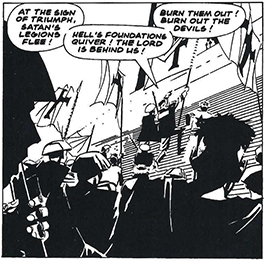
When I was pointing out the significance of doors in Deltarune, I somehow totally forgot about the bunker.

When Sebastian escapes Bedlam, his captor, Theo, calls in a group of assassins called the Roaring Boys to take him out.

I'm sure it's supposed to be a reference to "The Roaring Twenties," the post-WW1 boom before the Great Depression. Also, I initially misread it as "Surely you're not thinking of summoning the Roaring, boys?"
Klaus debuted a few months after Undertale so it's unlikely to have inspired Deltarune, or at least the first two chapters. Again, unless something more specific comes along, any similarities they share are probably overlaps in Morrison's philosophy. But the December 2018 issue (after the first seven-issue series, Klaus: How Santa Claus Began, the comic only released once a year around Christmas), "The Crying Snowman," features a sentient snowman wearing a green scarf with red stripes.
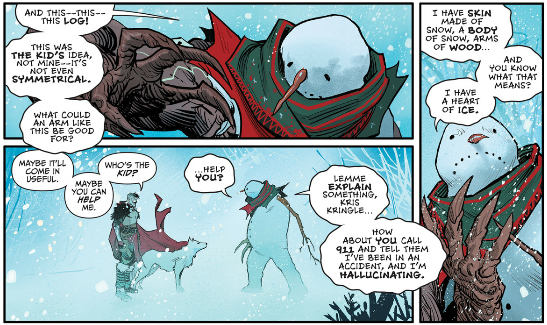
But in the shadows, the scarf turns indigo with magenta stripes.


But Deltarune Chapter 1 released a few months before "The Crying Snowman" and the comic had to already be finished or nearly so to publish in December, so this is almost certainly just a creepy coincidence.
Back when I was talking about the Doom Patrol show being self-aware, I speculated that was the show trying to combine Animal Man and Doom Patrol. Some of that might actually be from the Gerard Way run, which gets super meta at points. The first big fourth wall break comes end of Volume 2: Nada.
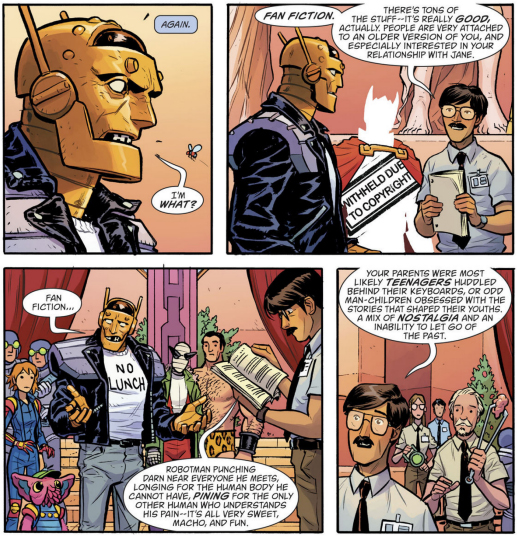
Later on, Cliff and a boy who fell into the comic from the real world have a conversation bizarrely similar to the one Caulder and Mr. Nobody have in the intro of Doom Patrol episode 2.
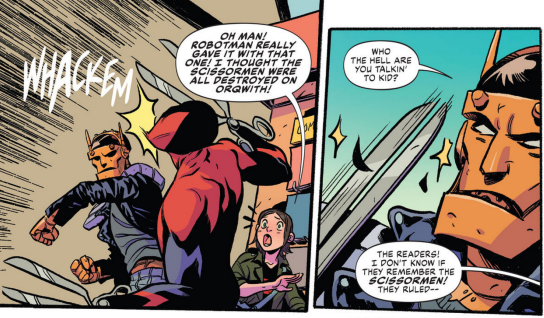
Yeah, Way himself probably got the idea from Animal Man, and Flex Mentallo telling the Doom Patrol about the "White Space," the area outside the story where Mr. Nobody resides, is totally from Animal Man especially since Flex illustrates the idea with a comic book.

And yes, we're talking about the same Gerard Way who sings for My Chemical Romance and wrote The Umbrella Academy and yes, Gerard Way is a huge Grant Morrison fanboy. Toby Fox wouldn't be the first person to have his mind imploded by Grant Morrison.
Remember back when I proposed Queen being inspired by Mr. Nobody? Mr. Nobody was originally Eric Morden, a mad scientist who only appeared in a single issue of the original Silver Age Doom Patrol where he tried to impress the Brotherhood of Evil by attacking the Doom Patrol in a giant robot.

He failed and that's when the Brotherhood of Evil forced him into the experiment that turned him into Freakazoid if he were an Earthworm Jim villain. At least in the comic, in the show he paid big bucks to undergo an experiment that turned him into this shattered, monochrome figure and sent him to the space between realities, from which he toys with the inhabitants of the lower reality.

Which is the fan depiction of Gaster. Again, the show debuted in 2019, a year after Deltarune Chapter 1 released, and was probably combining the original Mr. Nobody with the Overman battle from Animal Man. But if by some chance the Doom Patrol writers were inspired by Gaster, what do we call this, an Inspiration Ouroboros?
And yes, the robot's in the show, too.
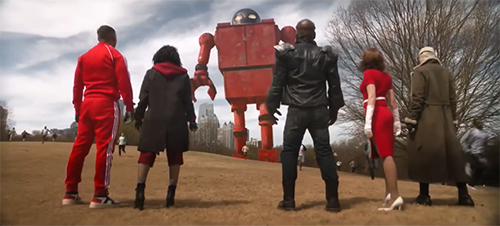
While looking up what else he'd done, I found Mr. Nobody's actor, Alan Tudyk, voiced King Candy in Wreck-It Ralph. Thought you might like to know that.
The whole time I kept referring to Fox being the Knight while using "the Knight" as a catch-all term for the game's villain, I completely overlooked there are two vaguely defined antagonists looming over Deltarune: the Knight, and the Angel. If Fox is the game's big baddy toying with everyone including the Knight, that would make him the Angel. While Fox is the creator of Deltarune and by extension its God, he's but a single inhabitant of our reality. Our reality is Deltarune's Heaven, which would make Fox one of the angels of Heaven. Balzizras was a literal angel that split off to craft its own perfect world after seeing what happened to Earth, only to have the whole thing collapse into war between the Insect Mesh and the Hussites.
Man, at the beginning of all this I said that if you asked me to pick one non-web comic most likely to be responsible for Fox I'd go with Animal Man. If you asked me that question now I'd ask you to let me pick two, but if you insisted I could only pick one - obviously several influenced him, just pick the one that did the most damage - I would have to go with Doom Patrol at this point. And I'm excluding webcomics because otherwise the answer would obviously be Homestuck.
Throughout Joe the Barbarian the main antagonist is an entity known as King Death who was imprisoned by the Iron Knight a decade ago. But the "final boss" is the Iron Knight, possessed and twisted by King Death, reflecting Joe's anger towards his father for dying.
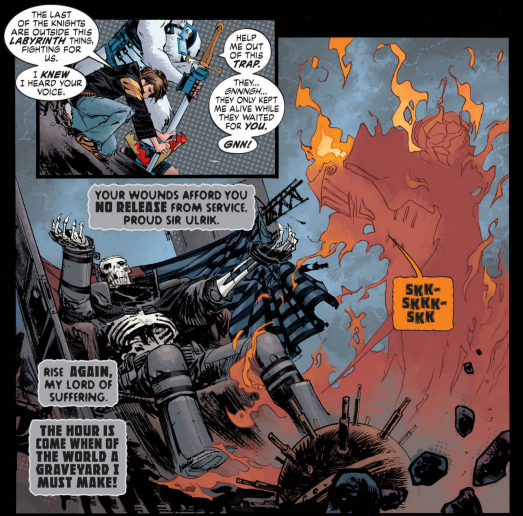
Fox has stated that the Roaring Knight will be the final boss of Deltarune, but if there's somebody pulling the Knight's strings, this would mirror King Death working through the Iron Knight.
Side note, I don't know for certain who Sir Ulrik, the firey knight that serves as King Death's main henchman through the book, is supposed to be. My best guess is he's the soul of the Iron Knight, kicked out of his body and enslaved by King Death. My second best guess is he's the dream version of the squadmate who stepped on the mine that got Joseph Sr. killed.
The primary antagonist of Klaus: How Santa Claus Began is this weasely guy called Lord Magnus who, long story short, screwed over Klaus a long time ago, stole his love, and is now working the town to death in the coal mines for something nefarious. At first his son, Jonas, is presented as a spoiled brat, smashing his expensive toys and claiming they're "never good enough."

But as the story progresses you learn Magnus' method of parenting was to shower Jonas with gifts and fuck off instead of, you know, being a father, and also never let Jonas play with other children so he effectively doesn't have much of an imagination and doesn't understand why his toys don't do anything. He becomes even angrier when Klaus starts sneaking toys to the other children and he sees the toys come to life in their hands only to die in his own, until his mother finally sits down with him and shows him you have to give the toys life.
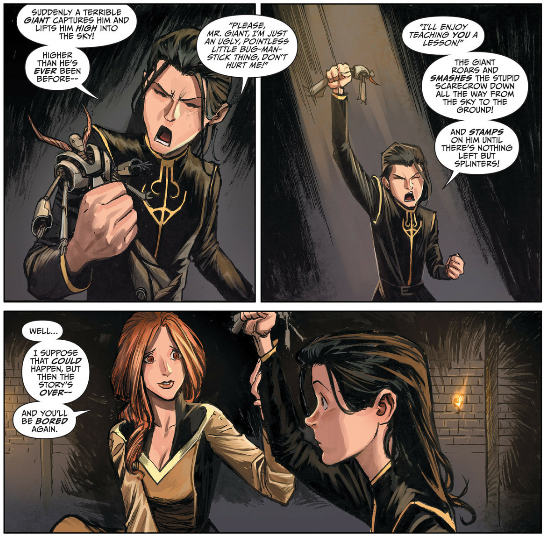
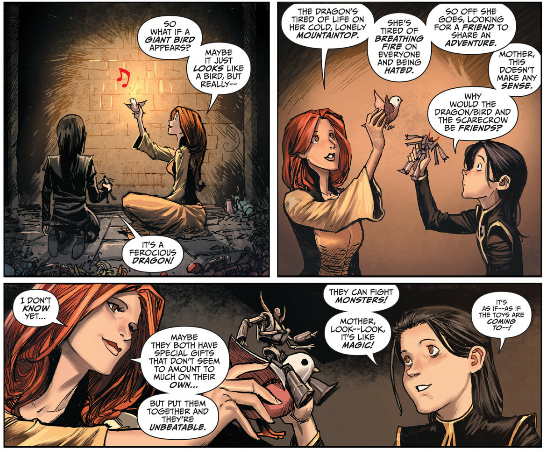
This mirrors Comic Book Limbo from Animal Man, where forgotten and unused characters are damned to aimlessly wander without writers to give them purpose. It's also a more heartwarming take the bleak message the abandoned classroom and Spamton NEO teach us: toys can't do anything on their own.

And isn't this the same case Undertale makes with its choice of Pacifist and Genocide routes? Isn't it more rewarding to treat your toys with kindness and form bonds with them than to smash them and move on to the next ones?
Here is a splash page from Zenith of a hippie robot riding a tyrannosaurus rex.

It has nothing to do with Deltarune, I just need to share it with as many people as possible.
The heroes of Flex Mentallo call the Crisis or whatever homage to it that's destroying the multiverse "the Absolute" and part of the plan to move themselves to another reality requires trapping a piece of "the Absolute" in a bubble.

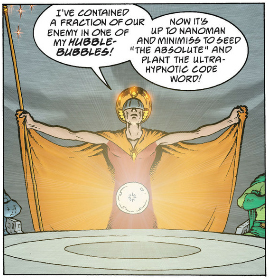
At the end of a Genocide run in Undertale, Chara tells the player "we've reached the absolute" before destroying the game.
When the buildup of Omega Radiation in Bruce's body begins to cause the All-Over, the page fills with rectangular distortions. Kinda like those rectangular distortions you see in the trash zone and Spamton's shop.
I hypothesized that the secret bosses are based on things you find at either amusement parks or any site of childhood amusement, and proposed a strongman and a monkey for future secret bosses. A sword swallower would be the best candidate for the boss we get Kris' weapon from. If another theme is that said things are intended to be endearing but are actually kinda creepy (clowns, puppets), well, Fox probably wants to avoid singing animatronics but costumed mascots have got to be on the table if he's not worried about comparisons to Hazel and Cha-Cha from The Umbrella Academy in the inevitable memes.
Going back to that page where the spirits imbue Klaus with the runes:

The Futhark Runes they're imbuing him with are Gebo, Wunjo, and Eihwaz which represent gifts, joy, and the yew tree. At least I think the last one is supposed to be Eihwaz because Eihwaz doesn't usually have those extra tics on the end, making it look like some weird hybrid of Eihwaz and Perthro (a dice cup).
But in "Klaus and the Witch of Winter" he claims the spirits imbued him with the runes of gifts, joy, and fire. However, the fire rune, Kenaz, looks like a < sign. Here's another site that says the same thing about Kenaz, and that Eihwaz means potential. And another that says Eihwaz means death, dreaming, and magic. And another that says Eihwaz means balance, life and death, connection between worlds, and sacred knowledge. Which is weird, because Eihwaz totally works here (no, Klaus does not bring death, but Magnus had nailed him to the ice and left him to freeze to death, so Eihwaz symbolizes the death of his old life and his rebirth into Father Christmas). Maybe a couple years down the road while writing the Witch of Winter issue, Morrison had forgotten which runes Klaus had been imbued with.
Scott Wallace made a fortune investing in video games (remember Zenith takes place in the UK, which didn't have a video game crash like North America did) so he might be a reference to Howard Scott Warshaw, but I wouldn't put money on it.
When Two-Face flips the coin to decide whether Batman is executed or allowed to leave Arkham, a lightning bolt flashes at the peak of the flip and Two-Face concludes "he goes free." One might say the air crackled with freedom there.
When Mr. Nobody is using Albert Hofmann's bike to send entire cities into hallucinogenic trances, Cliff is determined to put an end to it. But the rest of the Doom Patrol don't seem to care, even asking Cliff why he gives a shit about what Mr. Nobody is doing, since city-wide acid trips are hardly the worst thing they've dealt with. Or maybe they've given up because every time they fight the Brotherhood of Dada, they get it handed to them.
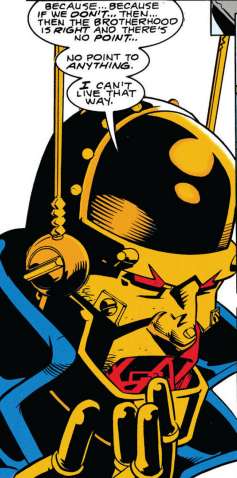
Deltarune repeatedly beats you over the head with the mantra "your choices don't matter, your actions don't matter, nothing matters."

I guess only time will tell if "your choices don't matter" is Deltarune's version of Rick and Morty's "Nobody exists on purpose, nobody belongs anywhere, were all going to die. Come watch TV." or Undertale's "kill or be killed," a dark philosophy that we can either give in to or, like Cliff up there, fight against because "nothing matters" only if we allow it to.
Why does the Deltarune Wiki not mention the high likelihood that Seam was inspired by the Cheshire Cat from Alice's Adventures in Wonderland?
Before the Omega Sanction hits Batman, he thinks to himself "Remember." Later when he's confronted by Blackbeard, he whispers to himself "Don't forget." "Don't forget" appears on a photograph in the secret room under Sans and Papyrus' house in Undertale, and in the credits theme of Deltarune.
There's hidden text in Deltarune's code of somebody asking if anybody can hear them and mentioning a scratching sound. In Arkahm Asylum, when the Joker is on the phone with Commissioner Gordon and Batman they can hear a scratching sound coming through, which turns out to be the Joker sharpening a pencil. Also the scratching sound in Arkham Asylum is coming through a phone, and there's something weird going on with phones in Deltarune.
Ruby Fox's elongated head in her Lloigor form (well, one of them since she can take any form she pleases) makes her look like Queen.
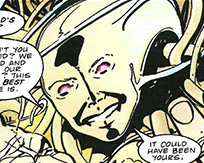
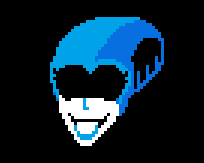
However, I feel like both are references to the Xenomorph.
Throughout Arkham Asylum Batman's face is constantly obscured by shadows and while every so often his face is lit up his eyes remain in shadow. His eyes are shown twice, during his fight with Killer Croc and when he asks Adams for Two-Face's coin, and both times it's hard to make out. Similar to another "dark knight" whose eyes are constantly obscured.
Bruce has to keep changing costumes when he travels through The Return of Bruce Wayne, the same way the Fun Gang change costumes during some ACTs (dressing up as doctors against the virus enemies, or dogs against the mice). Kris and Susie even put on pinstripe suits and fedoras when ACTing with the Shadowmen, like Bruce does in the prohibition era.
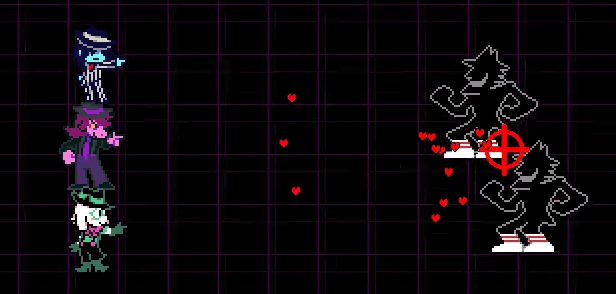
Not sure why Ralsei is dressed up like a cowboy instead, maybe he's an issue behind the others.
When Flex tells Dorothy to finish off the Telephone Avatar, she first tries to call for help from some of her other imaginary friends.
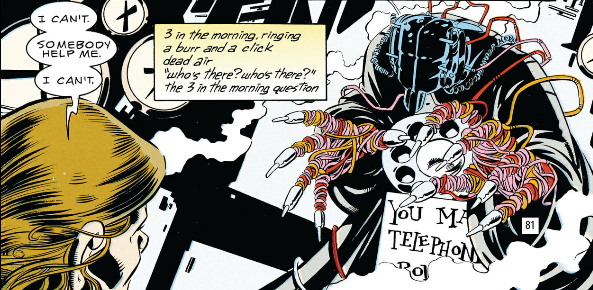
They don't answer, and she finally reaches out to the Candlemaker. It suddenly gets very cold, everything goes dark, and Flex tells her all he could hear was the sound of screaming horses. When you fight Spamton NEO on the Snowgrave route, you have to call for help at the end of the fight. Nobody responds, and finally you have to reach out to Noelle. Spamton comments on how cold it's getting, everything goes dark, and all you hear is a series of Iceshocks firing off.
Along with water, most of Bruce's time jumps are accompanied by an eclipse. I can't find it in the witch hunt or the wild west issues, unless it's not necessarily an eclipse but the moon that's important. There's also a mysterious box said to contain some earth-shattering secret. But I'm not recalling eclipses or mysterious boxes in Deltarune, so let's put a pin in these ideas and see if they come up later.
A big deal is also made about the cowl he was wearing when Darkseid sent him into the past, which was left in the stone age and turned into some kind of totem. I mean, it might parallel the Shadow Mantle if you squint a bit?
I can't believe it took me as long as it did to realize one of the flunkies prodding through Batman's memories being an ape is a reference to the Infinite Monkey Theorem.

Another thing that took me way too long to realize?
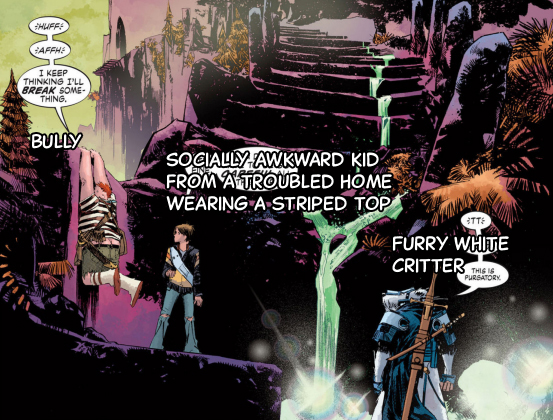
The Red Mask and the Veil battled Captain Triumph, a character originally from a universe where the Axis Powers won World War II known as Earth-X before the Crisis folded everything into one universe. But when the universe was split again Earth-X was restored only in this version Hitler won World War II because he got his hands on Overman. And in Animal Man, Overman was defeated with the help of the Veil. So the Veil fought an OG Earth-X character and somebody who would later be retconned into an Earth-X character. Was this an intentional inside joke on Morrison's part?
When Krampus takes control of Klaus' sleigh, there's some weird artifacting on it.

It's like this in the print version, too. Maybe it's supposed to be the sleigh "bugging out" as it transforms like a Super Nintendo game but I don't know why it'd be like that before Krampus corrupts it, so I think it's a glitch with the original file.
The "shadowy cyclops" from the end of time turns out to be Bruce himself. When he travels back to the present day he's wearing a cape of wires that gives him a broken outline and makes him look even more like a Roaring Titan.

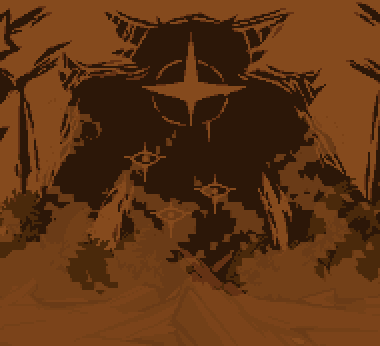
He also has one glowing red eye in this costume, like another "dark knight."
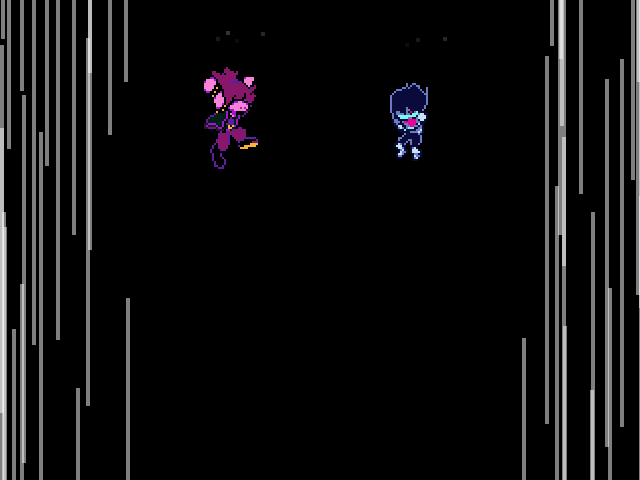
"Roaring" contains the letters I-R-O-N. And not to delve too far into tinfoil hat territory, you can rearrange "Iron" into "Ro-in" which sounds a little like "Roaring."
Fox apparently once said something about how "All chaos is ordered" in reference to the chaotic effects Pirouette has on the Jevil fight occurring in a fixed order based on the turn you're on. Now, who talks about order from chaos in Arkham Asylum? Oh yeah, the Mad Hatter.
Jonah Hex isn't particularly associated with Grant Morrison but he's well-known enough among DC fans and does appear in Batman: The Return of Bruce Wayne, and, well, I just noticed something...

But why would Fox reference Jonah Hex with Rouxls Kaard? I'm just spitballing but despite being an antihero, Hex does adhere to a strict code of honor so one might say he's a stickler for his own rules, while Rouxls Kaard's name is literally a play on "Rules Card." And Rouxls Kaard dressed up as a pirate in Chapter 2, so maybe he'll dress up as a cowboy in another.
And on the subject of stuff from DC that isn't Grant Morrison, in Green Lantern there are seven Lantern Corps (okay, six, there's only one Orange Lantern and you'll understand why in a second) each representing a color and an emotion, plus the White and Black Lanterns of life and death. Red is rage, orange is greed, yellow is fear, green is will, blue is hope, indigo is compassion, and violet is love. If you've ever heard of the Green Lantern's weakness being the color yellow, at first that didn't have any real explanation, but Geoff Johns retconned it to be because the yellow god of fear, Parallax, was imprisoned in the Green Lantern Corps' main power battery. Now, seven souls of seven colors representing seven attributes. Where does that sound familiar?
I didn't devote a section to 52 mainly because Morrison was only one of four authors on the book and most of the time it's hard to tell what was Morrison and what was Johns, Rucka, or Waid. But when Animal Man starts talking with Starfire about being abducted by aliens, leaving reality, and the nature of existence, that is definitely Morrison.


You might be wondering, "Is Buddy talking about meeting Morrison? Doesn't he remember that?" There's an ambiguity as to whether Buddy remembers meeting Grant or if his memories were wiped when Grant tells him to "forget we ever met."
Also note what Buddy says about "hands at the center of the universe." I'm not sure which of the four came up with a cult attempting to destroy Gotham with pillars of energy meant to make "a pit of fire roar at the city's heart" to fulfill a prophecy about Gotham losing its guardian knight, though.
I mentioned that I haven't been able to find any evidence that Animal Man has ever been officially translated into Japanese. That got me thinking, have any of Morrison's books ever been officially translated into Japanese? Turns out a handful have (I don't know why Dark Nights: Metal is included on that page, Scott Snyder wrote that) but many of them are long out of print, including All-Star Superman. Curiously, one of the few that is still in print is Arkham Asylum.
When Vertex uses the third Chaostructor to destroy Axis Mundi, he appears to be looking at the reader when he says "Bye."

After Superman and Wonder Woman get the Omega Radiation out of Bruce and resuscitate him, he coughs up a bunch of black goo. I think it's supposed to be the water he inhaled saturated with Omega Radiation, but whatever it is, man does it look like that black goo pouring out of holes all over that creepy cave from the start of Chapter 1.

Trano and Zaarn appear in 52 but are never mentioned by name. Zaarn appears to have only been named in Strange Adventures #184, which I've only been able to find... questionable methods to read that I won't link to here. In that comic they're straight villains, but Morrison retconned them into allies and when Buddy brings up their past treachery they basically say "Oh, that was all just a ruse, we're actually on your side."
Two more mistakes to address. First, when I originally posted Part 2 I had 2013 as the publication date for Joe the Barbarian. This was the publication date for one of the trades, but the original floppies published from 2010 to 2011. This is simultaneously tiny because it's a single digit from a date I only referenced once, and massive because it means Joe the Barbarian predates Toby Fox's 2011 fever dream that inspired Deltarune.
Second, when Lex Luthor gives himself Superman's powers in All-Star Superman he doesn't inject the serum, he drinks it. I know most people will shrug minor mistakes like this off and say "Okay, you misremembered this one detail because it's been a few years since you read All-Star Superman, but at least you have the general idea right" but I have to acknowledge stuff like this for the "Lawl, you said Luthor injected himself with the serum but he drank it, you have no idea what you're talking about and this entire document can go in the trash" crowd.
The "Hell" the Candlemaker sends Jane to is a world without superheroes, so I wonder if it's is the same recreation of our reality Buddy ends up in at the end of Animal Man.
As Jane is held in an asylum in this "Hell," she keeps slipping into a dream world where she's leading an army of chairs against an army of key-faced men called the Keysmiths and eventually joined by Cliff and Rebis until, again, the doctors use electroshock therapy to break her.
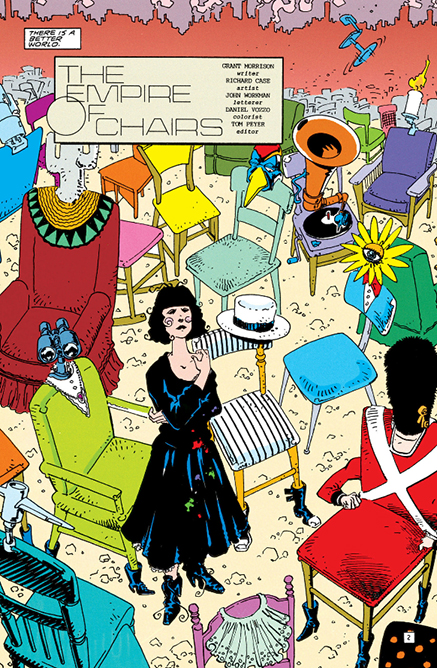
And either the Keysmiths, or both them and the chairs (Rebis only asks about the Keysmiths, but Jane could be referring to everyone in this world) revere her as an angel.
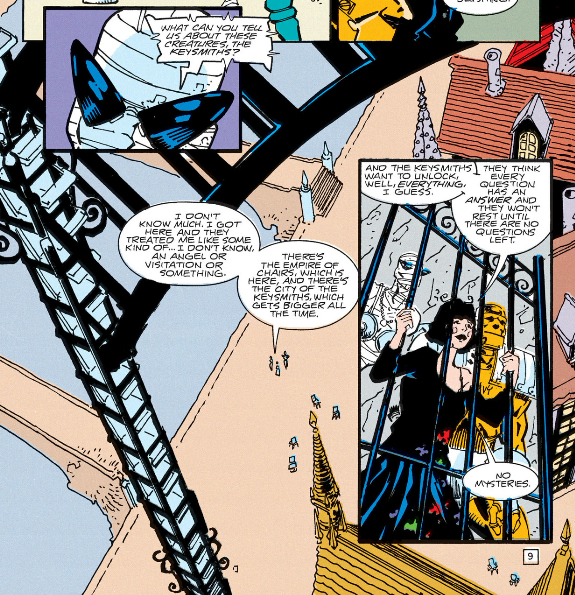
The Summer 2024 Newsletter suggests Chapter 4 of Deltarune features sentient chairs.

At this point I feel like Fox is trying to get somebody to pick up on Grant Morrison's influence on him and Deltarune. Maybe he wants to talk about Morrison but can't until either somebody else brings them up or the game is finished and he knows the latter is going to take years.
Deltarune, or at least the game's ending, is allegedly based on a fever dream Fox had in 2011. I swear to God this fever dream better not be "I was abducted by aliens from the fifth dimension who took me to their lab where they grow worlds in tubes" or "I made a pact with my staph infection that I would immortalize it in one of my stories if it spared me." Yes, that is something Morrison claims to have happened in Supergods and inspired a plot in The Invisibles.
Because the Deltarune community likes theories - which a bit of a misnomer but let's just go with it - let's try to compile everything we've talked about through this whole project into two starting with...
~~ The Morrison Theory ~~
Named so because it uses the philosophy of Grant Morrison as a guide to interpret Deltarune. While I've discussed most of this stuff in-depth through this project, let's summarize it with bullet points.
- The puppetmaster looming over everyone - be it the Knight, the Angel, or another entity manipulating both - is Toby Fox.
- Gaster is working for Fox to keep his story on track ala Trano and Zaarn.
- The water in the game represents the Dreamtime, the sea of potential that we are playing in when we form our own personal world within it.
- The Undertale characters in Deltarune are alternate versions of them, simultaneously the same and different, in the same way Batman of the Adam West TV show and The Animated Series are both Batman, but not the same Batman.
- The "Heaven" Spamton refers to is our reality, the implicate order out of which Deltarune unfolds.
- "Heaven" and "the Angel's Heaven" are two different things. The prophecy is worded as to make it sound like they're one in the same, but the former is our reality while the latter is the Roaring, the Angel's sick idea of a perfect world like the Lloigor's "Heaven" in Zenith or Caulder's catastrophe program in Doom Patrol.
- Fox is creating Dark Fountains and trying to cause the Roaring because there's no story otherwise. I'm sure there's some in-story reason that will be revealed down the line, but the real reason writers have to add conflict to their work is "because there's no story otherwise." If Fox is the Angel, the Roaring isn't actually his "perfect world" but the characters think it is because they don't understand why else he would be trying to cause it.
- The higher and lower realities need each other; without us our dreams don't exist, and without our dreams we don't live ("If you want to destroy a people, first destroy its dreams"). Contrary to the theories claiming everybody in Deltarune would be better off without us and we're assholes for forcing our will on Kris and the Roaring will only happen if we continue meddling with the game so we should just close the window and forget about it, nobody in this game can do anything without us. If you choose to quit when you get a Game Over, the message "The world was covered in darkness" appears because when you abandon the game the fountain shuts off, the dream ends, and their world vanishes.
- "Your choices don't matter" is Fox trying to tempt us into abandoning our emotional attachment with the world and characters and torturing its cast for entertainment. Our choices don't matter, the Roaring is going to happen no matter what, so why not just smash up our toys in a Snowgrave run?
- Ralsei is an imaginary friend based on Asriel like how in Joe the Barbarian the inhabitants of the Iron Kingdom are based on people from the real world: Chakk is Joe's rat, Zyxy is the girl who helps Joe after he gets bullied at school, Smoot is one of the bullies, Queen Bree is this mother, and the Iron Knight is this father. The reason Ralsei acts as some people would say "too nice" isn't because he's secretly evil and is buttering us up for a big betrayal, but because he's Kris' idealized BFF.
- The game ends with the characters meeting Fox, either directly or through the Annoying Dog. Assuming Fox doesn't change his plans to only have one ending, the ending is going to be whatever Fox wants to happen. Like Morrison giving Buddy his family back without explanation Fox gives them a happy ending, which means pacifist players also get the ending they want while violent and Snowgrave players are effectively told to pound sand. As for what specifically goes down between Fox and the protagonists... I 'unno. I'm not Fox, I don't know what his "fever dream" was, and I hope he wouldn't just rehash Animal Man's ending beat-for-beat.
So who's the Knight, what is their relationship to Fox, and why does Kris open a fountain at the end of Chapter 2? Did they open the Castle Town, Card Kingdom, and Cyber City fountains as well? How? That brings me to...
~~ The Yu Yevon Theory ~~
I'm naming this after Yu Yevon because "Sin Theory" makes it sound like I'm talking about the general concept of sin.
Let's give some backstory for those not familiar with Final Fantasy X's lore. There's this giant whale-like kaiju, Sin, that's been rampaging around the world for a thousand years, indiscriminately blasting the shit out of everything.
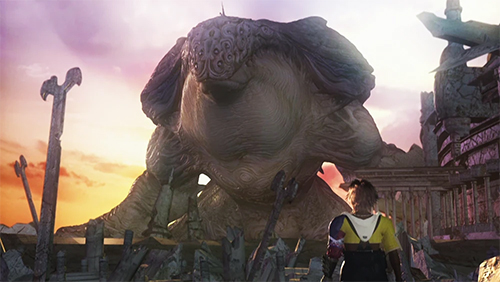
The party's end goal, at least at the start of the game, is to journey to the ruins of Zanarkand, a city that was destroyed by Sin when it first appeared, and acquire a spell powerful enough to destroy Sin. Albeit only temporarily, as this same method has been used to destroy Sin before and it keeps coming back.
Fayth are people who've had their souls ripped out of their bodies and sealed into statues. Final Fantasy X's summon monsters, Aeons, are the dreams of Fayth manifested into reality by a Summoner. The aforementioned spell that can destroy Sin is an incredibly powerful Aeon called a "Final Aeon," called so because the Summoner dies when they use it against Sin.
But deep inside Sin is the soul of Yu Yevon, the last emperor of Zanarkand. Zanarkand was losing a war with the city of Bevelle and rather than surrender, Yu Yevon turned the entire city into Fayth and used that font of power to create a dream copy of Zanarkand and Sin as a combination mobile fortress and weapon against Bevelle. When a Final Aeon destroys Sin that releases Yu Yevon, who then possesses the Final Aeon (the psychic backlash from this is what kills the Summoner, not the actual act of summoning it FWIW) and goes into hiding as he turns that Aeon into a new Sin.
At the end of the game, the party finds a way to cut into Sin without a Final Aeon and destroy it for good (we don't talk about Final Fantasy X ~Will~ in these parts, kiddo). After defeating Braska's Final Aeon - Braska being the last Summoner to defeat Sin - you summon the standard Aeons to be possessed by Yu Yevon, then strike them down because when an Aeon is "killed" while possessed by Yu Yevon it destroys the statue containing the Fayth so that Aeon can never be summoned again, and he only becomes vulnerable when he has no more Aeons to hide inside.
Here's a video of the last three battles of FFX for anyone who wants to see what I'm talking about. Obviously there's more to FFX like the Church of Yevon, the Pilgrimage, the Farplane, Machina, the Al Bhed, pyreflies, fiends and unsent, the ins and outs of Aeons and why Yu Yevon possessing a Final Aeon kills the Summoner, and so on, but I'm trying to stick to only what I need to to explain this theory, that being:
Any Aeon taken over by Yu Yevon becomes Sin.
To which I propose, any character taken over by Fox becomes the Knight.
Based on the ending of Chapter 2, Kris is the Knight of Chapter 3's world. Who are the Knights of the Cyber World, the Card Kingdom, and Castle Town?
For the Cyber World, Noelle was at least one of them. See, one of the Aeons, the Magus Sisters, is actually three Aeons, formed from three sisters sealed into the same statue.

And Yojimbo is accompanied by his dog, Daigoro.
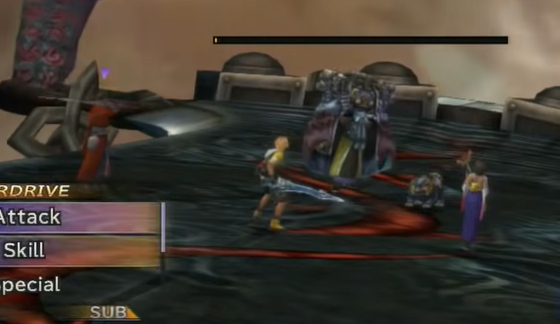
But when you summon them in the Aeon Battle, Yu Yevon takes them over as one. Just as Yu Yevon can possess the Magus Sisters and Yojimbo with Daigoro as a single core for Sin, Fox could have possessed both Noelle and Berdly and had them create the Cyber World together. Or he only used Noelle and, I dunno, put Berdly to sleep while he did it?
Now how about the Card Kingdom? Nobody else appears alongside Kris and Susie in the unused classroom when they close the fountain.
The first and more likely possibility is that Fox can also take over Darkners. Braska's Final Aeon was created from Jecht who was an inhabitant of the Dream Zanarkand, so Yu Yevon can use the dream of a dream to create Sin. This would make Rouxls Kaard the best candidate for the Card Kingdom Knight.
The second but less likely possibility is that, just as Yu Yevon created the first Sin without an Aeon, Fox doesn't necessarily need to possess another being to create a Dark World, it just helps shape it and Fox created the Card Kingdom on his own. What makes me doubt the possibility of this is that you'd think the Card Kingdom fountain would also emit pure Dark Energy if it was created without using an in-game character to shape it.
And finally, who did Fox use to open the Castle Town fountain? Us. He uses us to create the fountain in the storage closet. It emits pure Dark energy because we are above even the Lightners, we will shape its world as we play the game and recruit inhabitants, and the town is named after us. Or at least whatever we claimed our name was, which I guess means Luigi is the creator of the Castle Town fountain in my file.
Alternatively, Fox is the Knight, but he still requires another being as a sort of conduit to create a fountain. In this situation, Fox could be compared to a Summoner, who needs to bond with a Fayth to conjure an Aeon.
I should clarify I am not suggesting that, if true, Fox got the idea from Yu Yevon and Sin - although I find it hard to believe he's not aware of Final Fantasy X - I'm just using them to illustrate the theory. But it would be interesting if he did because like Deltarune, Animal Man, Berserk, and to some extent Link's Awakening, Final Fantasy X is a story where dreams are strongly connected to water. In fact, when the party finds the mass of Fayth in Mt. Gagazet that Yu Yevon is using to maintain the Dream Zanarkand and Sin, there's a giant pillar of water shooting up into the sky.
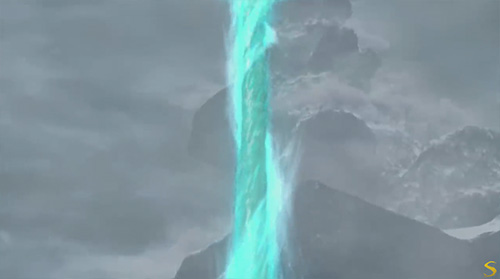
Also worth mentioning, Yu Yevon is technically the final boss of Final Fantasy X but because your characters have permanent auto-life you can't lose to him or the Aeon Battle outside of petrifying your own characters (which, now that I think about it, is like the Asriel battle in Undertale), so most people consider Braska's Final Aeon the game's true final boss. Another example of this would be how the Ouroboros is technically the final boss of Xenogears but you have to be trying to lose to her so again, Deus is generally considered the true final boss. Maybe the Knight is the "final boss" of Deltarune in the same sense, in that they're the final challenge, but after dealing with whoever Fox is currently using as the Knight (perhaps the vessel we create in Chapter 1), we confront Fox himself.
And maybe it's just the "spiky horned brute" motif, but the middle Titan kinda looks like Braska's Final Aeon, especially if you read Jecht's face as an eye.


Of course, while you could rework the Yu Yevon Theory for Gaster or our hypothetical Raha, most of the Morrison Theory hinges on Fox being the one toying with everybody and as I've said before, I don't actually believe he is. Which leaves me wondering what he is getting at with "Kris is the player's puppet and the player is the game's true villain."
Angry? I've been FURIOUS ever since I found out the whole point of Deltarune is that the player is the true villain and even pacifist players are bastards for barging in on these characters' lives and making them dance for our entertainment. I feel like Fox invited me to his house to play with his new toys, then punched me in the back of the head when I touched them. A large reason it's taking me so long to finish that Spamton comic is because, as much as I want to finish what I started, I can't work on it for very long before I ask myself why I'm drawing fanart for a world that doesn't want me in it and ragequit. As if I didn't play Deltarune to get away from a world that doesn't want me in it for a while.
"Wait, you're basing this on one fucking MatPat video? The guy who did a video on whether or not Princess Peach's boobs were real?"
Matpat didn't come up with this theory, he just compiled it into a nice, digestible video for his audience and acted like he came up with it like the weasel he is. I've been seeing it since the early days of Chapter 2. The first place I ever saw it was in the comment section of a Spamton meme video (and no, I don't remember which Spamton meme video this was) where somebody flatout said "The player is the true villain of Toby Fox's games." Games plural, because it turns out I was also the villain of Undertale. And Fox did say I'm supposed to name the Fallen Child after myself because regardless of how I play I'm the psychotic little shit that poisoned Asgore, tried to murder my village, got my adopted brother killed, is called "[not] really the greatest person" by Asriel, and is on the Devil card in the Undertale tarot deck, so that checks out.
Also, look at the responses:




The chance of this being true should be fucking zero. Or at the very least only apply to a full-game Snowgrave run, but the game is only going to have one ending which means Fox has to either reward or punish everybody. And I guess we're going with the latter, because whenever anybody asks how any of this applies to pacifist players, the answer is always "You're still manipulating Kris, you asshole."
"Why the hell would Fox create a game where his message to the player is 'You're an evil sack of shit for playing my game'? What theme or message would he be trying to convey with that?"
How should I know? I haven't watched or read every interview he's ever done, so I was naively under the impression the game was about finding the nuggets of joy in a hopeless world or something. Then I took a peek at the community that has been tracking everything he's said, and what do they keep saying? The player is the game's true villain.
The player is the game's true villain.
The player is the game's true villain.
The player is the game's true ALL RIGHT, TOBY, I FUCKING GET IT, GOD.
"You realize 'The player is the game's true villain and even pacifist players are self-aware control freaks' is a fan theory and could totally be wrong, right?"
The theory's existence is not the problem. Anybody can come up with any ridiculous theory they want. In fact, I'm going to propose right now that Batman is the Roaring Knight:
But why would Batman want to cause the Roaring? Haven't you read All-Star Batman and Robin? Why wouldn't the Goddamn Batman want to destroy any world with a shred of levity?
Obviously this is complete bullshit and nobody's going to suggest otherwise. People might shitpost about Batman as the Roaring Knight "Sans is Ness" or "Jimmy Carter is the Knight" style, but nobody's going to take it seriously. Nobody's going to believe for even a second that Deltarune could really end in an epic showdown against the Goddamn Batman. Nobody's going to call anybody else "braindead" for thinking it makes no sense or make memes mocking people for not understanding Toby's genius. Nobody's going to say "this one actually has a decent chance of being true."
Of course, if you wrote fanfic where the Goddamn Batman is the Roaring Knight, that would make the Goddamn Batman the Roaring Knight of that alternate universe you've just created, but let's stay on track here.
So I ask, why is "the player is the game's true villain regardless of whether we play pacifist or Snowgrave, and the game is going to end with the characters kicking us out because we're unwanted invaders in their world" taken so seriously? If it has no grounding, how the hell did it gain any traction, much less become the most commonly recited theory? It should have been kicked to the curb the first time somebody proposed it. Instead, people have been treating it as hard canon ever since Chapter 2 released and praising MatPat for spreading the gospel. Hell, according to this thread people get dogpiled on the Deltarune Subreddit for not believing this narrative and suggesting alternatives.
If you believe Deltarune has even a sliver of a chance of ending with the characters rallying against us to banish us from the game because their world was never meant for us and regardless of how we play we're bastards for invading it, then you believe Deltarune is nothing more than a honeypot, a fake environment disguised as a legitimate one Toby Fox created to bait us in and catch us committing the sin of trying to distract ourselves from our own shit lives and dead dreams for a while while he rubs shoulders with famous composers and developers. You believe he is willing to spend half of his life tricking everybody into believing he's making the game to make us happy, take our money, and then tell us all to go fuck ourselves. You believe he would rope in a team of people to waste years of their time and energy on his game where his grand message to everybody is "You were never welcome here." You believe he would use a goddamned global pandemic and put together an entire a charity drive to fuel his lie. You believe his greatest dream is to create the biggest "fuck you" in the history of video games. And to top it off, you believe he's using one of his puppets to absolve himself of all responsibility for his prank. And the number of people who considered all of this and decided "Yes, that's exactly what he's doing! Dude's established himself as a master of trolling and subverting expectations, and what would be more subversive than spending two decades blowing smoke up everybody's asses about "friendship," "love," and "dreams" then pulling the rug out from under everybody and telling us to eat shit? This makes perfect sense and you're braindead if you believe otherwise!" has me wondering what I've been overlooking all these years.
"What makes you think the people parroting this theory have ever considered any of that? You know damn well nobody stops to think and ask questions about anything anymore. Or have you already forgotten how you lost most of your TurboGrafx and Dreamcast games?
"What makes you think fans of fucking Game Theory, the second biggest source of erosion of media literacy on YouTube after goddamned CinemaSins, would watch a MatPat video and think 'Waaaait a minute, this is bullshit!'? Haven't you heard the saying 'Don't ask questions, just consume product, then get excited for next product'?
"What makes you think the people who believe Deltarune is going to tell you off for playing it because... *checks notes* Spec Ops: The Line does so after making you burn people to death with white phosphorous have any idea what they're talking about?"

"If the edgy teenagers spouting this garbage had stopped for five minutes to think about it, they would have realized the same thing you did the first time you heard it: the whole thing falls apart as soon as you ask about the man behind the curtain. You have to have no idea how art works, and pretend it just spawns out of the ether and isn't created by a human being trying to say something even if it's just a child saying "I love my doggy" or "I think Spider-Man is cool" with a crayon drawing. Hell, if the people pushing this theory had ever thought about Fox during it, they would be proposing him as the Knight.
"Instead, you've got kids trash talking others' media literacy while they themselves don't even know what death of the author is. Sure, a lot of people misunderstand death of the author and think it means "the author's intent is irrelevant and a work can mean whatever the hell I want it to" or that it only applies once the author is actually dead, but at least they understand it's valid if people interpret a work different. And people just wanting to explore another possible world where things were a little different doesn't mean they don't understand canon. Besides, according to the Shrug of God page, Fox deliberately left stuff ambiguous in Undertale so people could fill in the blanks for themselves, so he's probably perfectly fine with people having different interpretations of his work and characters and seeing Spamton as a case of "hurt people hurt people" and not the irredeemable backstabber even on the Normal route they think he is. The ultimate irony is that the "truth" they've been the only ones smart enough to solve is just their own interpretation.
"And if MatPat ever thought about artistic intent, subtext, morals, theme, or anything but his own fucking view counts, he would have considered that maybe "your joy comes at everyone else's expense, even when you try to do good you just make everything worse, and if you truly care about the people around you you will 'respect their autonomy,' do the right thing, and remove yourself from the world so everybody else can get on with their lives" isn't a message he should be promoting to his audience of impressionable children and depressed teenagers.
"Seriously, these kids are using Spec Ops as proof Toby Fox would make a game where you're evil for playing it? Right, and Grant Morrison should have ended Flex Mentallo with Wally picking the drugs and killing himself because that's what Garth Ennis would have done."
So what did Fox mean when he said I was supposed to name the Fallen Child after myself?
"I don't know. Maybe it was supposed to be a silly subversion on people naming heroes like Crono, Cloud, and Locke - or Lucca, Tifa, and Terra - after themselves when, lol, you were actually naming the villain after yourself, and forgetting *why* people name characters after themselves he didn't realize he was suggesting you were the villain. That is an archive and the original tweet is gone, so maybe he deleted it when he realized what he was implying. Or maybe the Fallen Child isn't supposed to be you but your shadow, who you could be in a dark timeline where you give in to hatred and violence, as symbolized by the Devil card. You've said in the past that the whole point of Frankenstein is that the monster is the doctor's dark reflection so it's fine to call the monster "Frankenstein" as well. Maybe they're even supposed to be like the Cassandra Nova to your Professor X but again, that mentality doesn't translate well into video games because when people name Squall or Dagger after themselves they're not saying 'This character just happens to have the same name as me' or 'This character is my dark reflection' they're saying 'I am this character.'"
Then who's Frisk? So what, when I'm violent I become my dark self but when I'm nice I become... a completely different person entirely? Is that why Asriel mistakes Frisk for the Fallen Child, or is it because he senses me, the Fallen Child, controlling Frisk? And why would Asgore telling the Fallen Child to "stay determined" on the Game Over screen apply to me unless I'm the Fallen Child?
"You are convinced that Toby Fox was inspired by Grant Morrison, right?"
Yeah, if the Telephone Avatar and Joe the Barbarian didn't quite do it, Peter St. John's prophecy about the "angels' heaven" clinched it.
"So why would he then choose to become the Anti-Morrison?"
...
"Look, you've been going through some shit recently. You lost three cats within twelve months, you've taken in a diabetic cat who won't stop pissing on your floor, your mental health is still a wreck from your last job and you still have problems with your left foot, and everything else you're putting up with has made you cynical. I'm sure things will be fine. And if by some chance the game does end with Fox telling you you're a stupid bitch for playing his game and to get the fuck out of his world, that's years away. There's no reason you can't play in it until then."
Let's see if Chapters 3 and 4 clear the air any.